11 Top Temples in Chiang Mai | Review + Visitor’s Guide

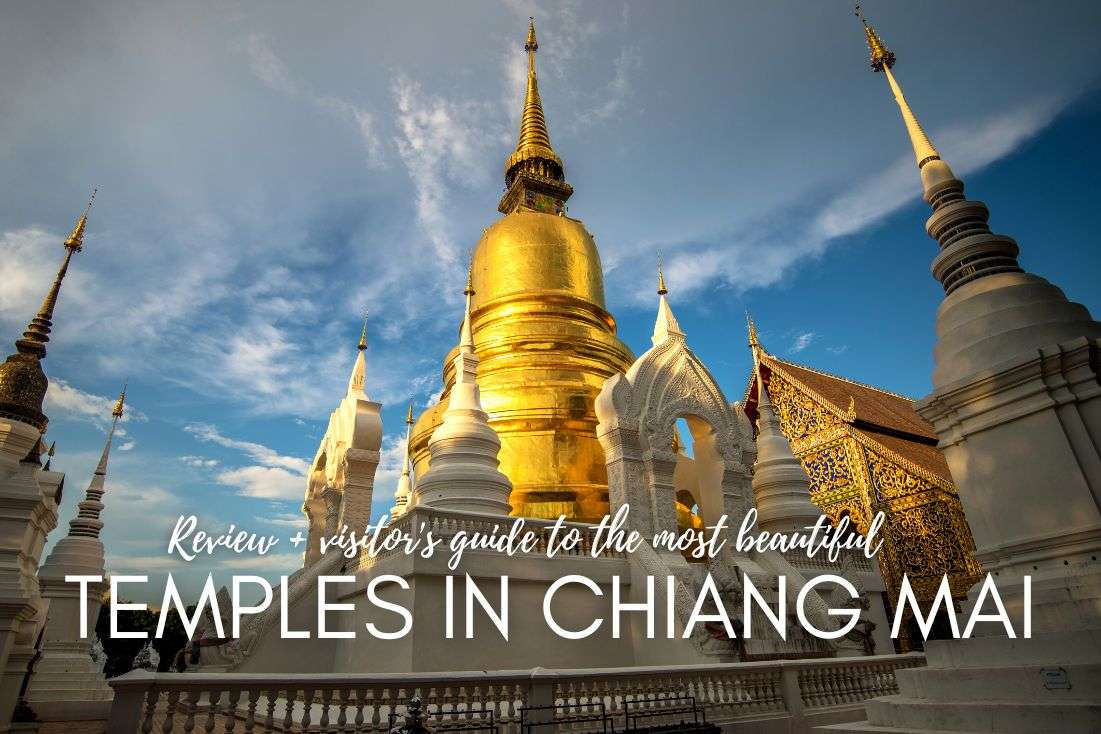
Whether you're mingling with saffron-robed monks or sipping on expertly filtered coffee (thanks, digital nomads!), you’re never too far from the next temple in Chiang Mai. This city, my favorite in all of Thailand (with Bangkok coming in at a close second), effortlessly bridges the ancient and the contemporary. Nestled among the northern hills of Thailand, this city was once the heart of the Lanna kingdom for nearly five centuries, leaving a legacy of over 300 temples… not that you’ll have the time or even desire to see them all. That’s where I come in.
I’ve done several temple crawls in Chiang Mai over the years, and I can honestly say that… 300 is a lot! And they all start looking the same after a while. So, which ones are the must-sees? The ones that stand out from the crowd. The popular temples in Chiang Mai’s Old Town are no-brainers, they’re famous for a reason, but make sure to venture past the moat, too—you’ll appreciate the variety and prevent temple burnout, not to mention run into fewer crowds.
Tip: Chiang Mai is the perfect base for exploring a good chunk of northern Thailand, not just the city itself. My 5-day Chiang Mai itinerary has you visiting most of the temples on this list (like Wat Pha Lat on the Monk’s Trail), but then hops over to an elephant sanctuary, visits some waterfalls, and optionally has you staring into Burma. Oh, Chiang Mai, how I love thee!
Check out the whole section Thailand, where you can see all I visited.
Or if you are interested in just the Northern Thailand Itineraries, check it out.
Chiang Mai temples map and city orientation
The locations of all 11 of Chiang Mai’s top temples. Get the list on Google Maps
Chiang Mai’s Old Town is an almost-perfect square of 1,6 km2, surrounded completely by a moat, over which there are numerous bridges that take you across to the inner city. It’s a compact area where all the tourists congregate.
What does that mean? It’s busy! But there are some great hotels, eateries, shops, and markets—all set against the backdrop of these historic temples.
It’s the temples and the presence of monks that keeps Chiang Mai from spilling over into tourist trap territory (looking at you, Ao Nang!). Yes, there are still tons of non-locals, but you always feel like you are in a living, breathing city where locals aren’t a rare species.
Of the 11 temples on this list, just 4 are in Chiang Mai’s Old Town. The others are within a reasonable distance from it, easily reachable by Grab (my taxi app of choice in Thailand) or on foot. You’d be missing out on a lot if you just stuck to Old Town, trust me.
Tip: Check out the vocabulary list at the end of the article. It includes some of the main temple words you’ll run into.
My hotel tips for Chiang Mai:
Coucou Hotel in Old Town: Small hotel in the ideal spot just barely still in Old Town (north), close enough to all the Old Town temples, but also right at the moat, making getting out of tourist central easy peasy.
Villa Tha Phae close to Tha Phae Gate: Super cute hotel with just 6 rooms and a small, luscious garden, our room had direct access to the pool, which felt luxurious (but the water was a tad on the cold side).
Chiang Mai’s best temples
I’ve put the temples on this list in order of how much I personally like them, which is obviously subjective, but they’re all on there for a reason. The reason being that they are objectively awesome. Each one has something special about it, standing out from the crowd of Chiang Mai’s hundreds of pretty temples—because that’s what it comes down to. I’d say all of the temples in Chiang Mai are at the very least nice, right? All have that spiritual atmosphere, golden decorations, incense, and lots of Buddha statues. But since you’re after the best, you won’t be happy with just any nice temple.
That’s why the first half of this list could be called “absolute must-see temples in Chiang Mai”, and the second half is at least “you’ll miss out if you don’t go”. Basically, you need to go to all of them.
Note on opening times: Most temple grounds are open 24/7, but the temple buildings usually close around 5–6 pm. That means you can often walk around until the evening, but it’s no longer possible to see the interior of any of the temples. They open early in the mornings around 5–6 am.
1. Wat Chedi Luang: So good they decided to leave it partially ruined
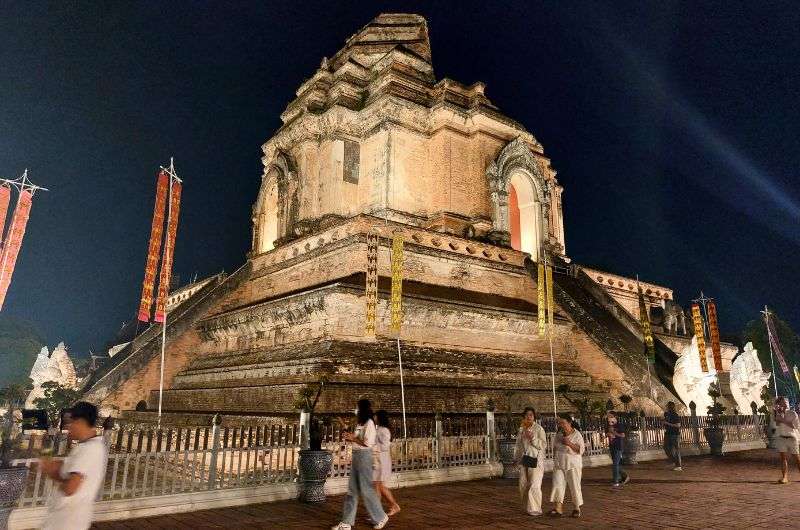
People walking clockwise around the chedi during the evening of Makha Bucha Day in 2024
Admission: 50 baht
Location: In Old Town
Why it’s special:
Wat Chedi Luang is Chiang Mai’s poster girl. It’s large, and not just by name, which means “Temple of the large stupa”. You come here mainly for the huge central chedi that is a crumbling but magnificent reminder of the city's glorious past, and once used to be the tallest building in all of Lanna Kingdom.
It was supposed to hold a king’s ashes, housed one of the top influencers of the Buddhist world, the Emerald Buddha, and was taken down a few notches by an earthquake.
Petra’s review:
The partially ruined but still very much revered chedi is the main focal point of Wat Chedi Luang’s temple grounds and one of Chiang Mai’s unavoidable landmarks. Yes, there is an actual temple here, but you’d almost miss it when you’re making a beeline to the epic centerpiece.
What I love about Wat Chedi Luang is that the grounds are bustling with monks going about their daily lives (they live on the premises) and local devotees making their offerings. You’d expect this place to be a tourist attraction par excellence, but it manages to keep its true meaning, which I appreciate.
Once in, the first thing you see is the shrine that holds the city pillar. And if you’re a woman, that’s literally all you see, because you are not allowed to go inside to see the actual pillar, because of bad girl juju or something. But you can peek in through the doors to see a very fancy interior.

Me: I don’t know what their problem is with women entering the shrine.
Them: ...
Also notice the three huge dipterocarp trees on the grounds that assist the city pillar in protecting Chiang Mai.
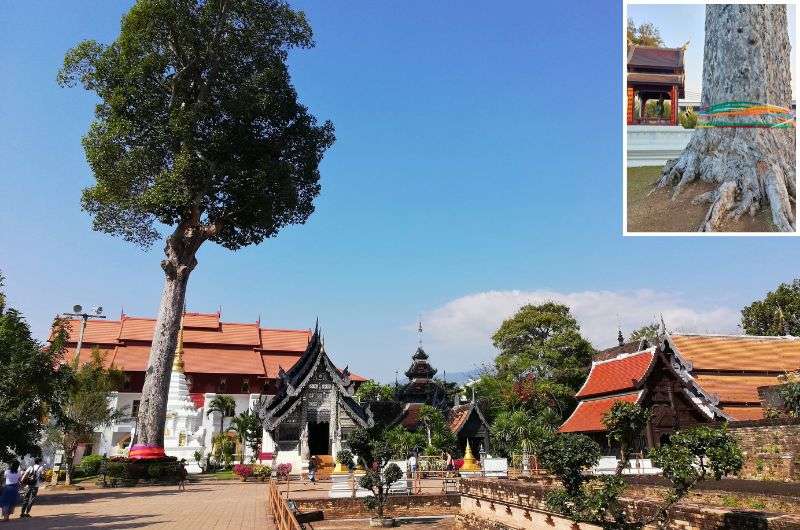
It’s impossible to take a photo of these giants. I don’t know if they truly help protect the city, but they sure are massive!
The massive chedi in the center of the grounds is hauntingly beautiful, its base adorned with fading elephant carvings emerge from the ancient brickwork (all apparently not original though). There is a window on each of the four sides atop a steep staircase with a different Buddha statue in every one. The main fella is the smallest one facing the east: a replica of the Emerald Buddha (now a black jade Buddha) that once sat in this very spot (he now lives in Bangkok’s Wat Phra Kaew at the Grand Palace—see my Bangkok itinerary for details on Emerald Buddha… and his robes).
Around the chedi there are numerous other buildings, some serving as monk’s quarters, others housing different sacred images and Buddha statues. Make sure to take time to peek in every one, because they’re not just your regular run-of-the-mill Buddha statues and are quite nice. Except for that one fat guy… he’s apparently not a Buddha but an eccentric Chinese monk (poor guy’s ceiling was half falling off, too).
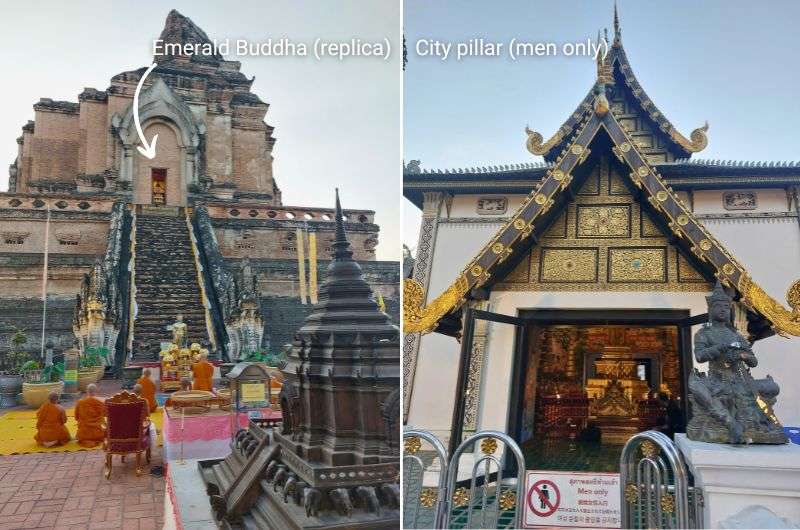
Some of the most sacred parts of Wat Chedi Luang
The main temple of Wat Chedi Luang was closed on our last visit in February 2024, because it’s undergoing restoration works. But from my other visits I know it’s a nice hall where all of the creative energy was spent on the elaborate golden pillars and then obviously ran out when it came to the walls, which are just plain while.
I ended up in Chaing Mai on Makha Bucha Day, which is a big Buddhist holiday celebrated by Buddhists far and wide every February (not just in Thailand—I was invited to the evening celebration at a temple near Hoi An in Vietnam a few years ago, and it blew my spiritual socks off!). Wat Luang Chedi is one of the main spots you can experience the festivities. I already walked into the fun at Wat Pha Lat the day before, and I can’t quite put my finger on it, but being able to be there among the monks and locals during this special evening was a very cool experience.
There were many people circumambulating the chedi in a clockwise direction while listening to the melodic chanting… and so I, determined not to make a mockery of such an important tradition by doing something I have no place emulating, slowly walked in the other direction, probably disrespecting them even more (so so sorry!). Good job me, overthinking strikes again!
Extras:
There are daily monk chats at Wat Luang Chedi. They are free and open all day until about 6 pm, and you’ll find them easily: look for the big banner and monks at tables talking to foreigners! I did this years ago and my tip is to prepare questions beforehand. The rule is to talk about Buddhism and Thailand in general, but don’t expect a conversation. It’s more simple answers to your questions because the monks you’ll be talking to are mostly novices and their English is basic at best and the talk might not flow that easily. You go for the experience, they do it to practice English. People ask them the same things over and over, so try to be creative. I’m sure “why did you become a monk” falls into the category of Qs that helps them practice restricting eye rolls the most! Oh, and yes, even women can talk to the monks.
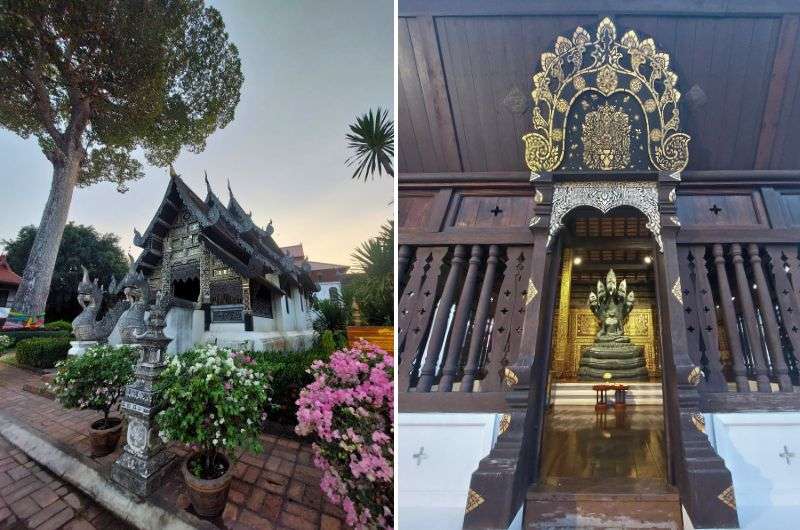
It’s not just the central chedi that is worth your time at Wat Chedi Luang, the surrounding buildings are impressive as well
Wat Chedi Luang history:
Construction of Wat Chedi Luang started in the 14th century during the reign of King Saen Muang Ma. The king started the project to honor his father’s ashes, but it took nearly a hundred years to complete, so, um, he basically died trying.
The temple reached its peak in the mid-15th century when it housed the revered Emerald Buddha. This significant relic remained there for about 80 years before being moved to Luang Prabang in Laos. But Wat Chedi Luang's story took a dramatic turn in 1545 when a massive earthquake struck Chiang Mai, causing significant damage to the chedi. The upper part of the chedi collapsed, reducing its height from a towering 82 m (270 ft) to its current 60 m (197 ft).
Wat Chedi Luang has never been rebuilt to its original height—a decision that preserves its historical integrity (=they don’t know what the top originally looked like and don’t want to butcher the reconstruction) and as a reminder of the impermanence central to Buddhist teachings.
2. Wat Pha Lat: The jungle escape you can hike to like a monk
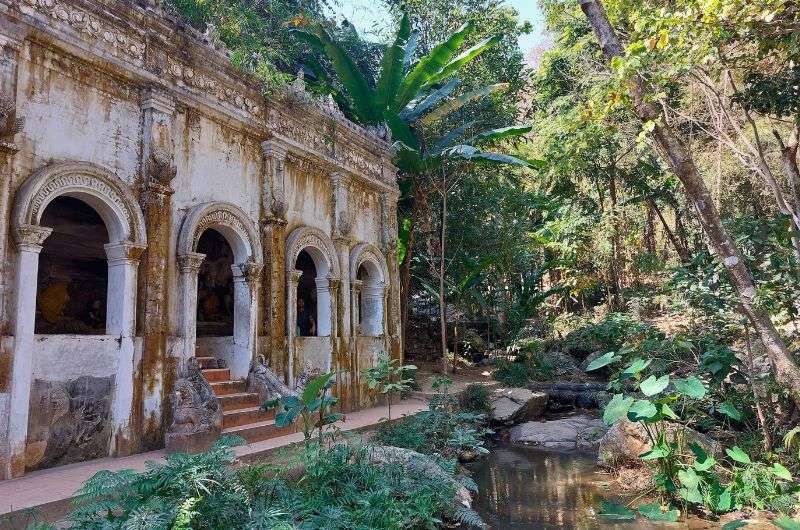
Wat Pha Lat temple deep in the jungle (if you forget about the road)
- Price: free
- Location: On Doi Suthep
Why it’s special:
Wat Pha Lat is a serene sanctuary wrapped in jungle and tranquility… and sometimes sweat, if you decide to hike up the Monk’s Trail to get here (a must-do in Chiang Mai). It’s a temple on the mountain next to Chiang Mai, Doi Suthep (not to be mistaken for Wat Phra That at the peak!). It literally looks like it sprung up from the jungle like some sort of magical Buddhist wonderland.
Petra’s review:
You can reach Wat Pha Lat via the Monk's Trail, which has now morphed into a well-trodden path clearly meant for tourists. The monks, wise as they are, have carved new trails deeper into the jungle where they can find peace and quiet away from us annoying, errm, curious visitors. (Check out my guide to the Monk's Trail). But you can also drive there if you’re on the lazy side.
When I first spotted Wat Pha Lat five years ago, I immediately fell in love. It sits serenely in the middle of the jungle, blending seamlessly into its surroundings. It was like stumbling upon a secret monk hideout! Sure, there’s a road leading right to it from the other side, but hey, a girl can dream! You can read all about my exciting first ascent to the temple at the end of my Monk’s Trail guide (by exciting I mean we got lost and it got a little messy).
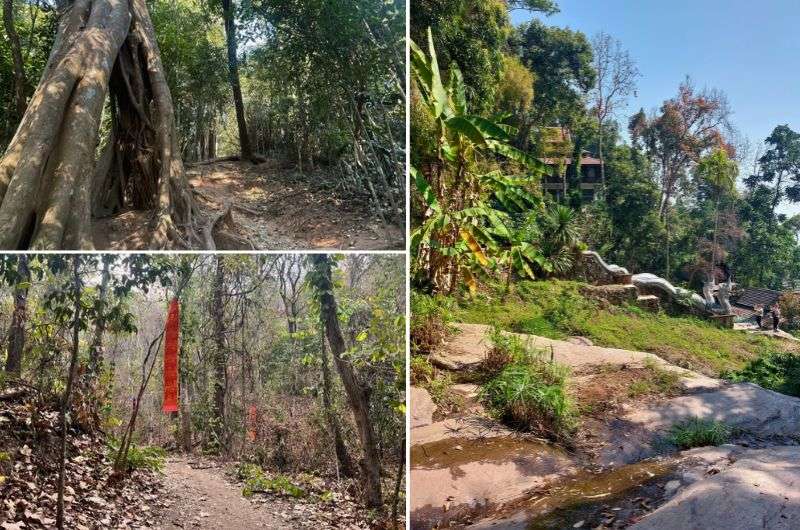
You follow the ex-Monk's Trail (because they don’t take it anymore) up to Wat Pha Lat, approchaing from the bottom at the waterfall (on the right... not much water this year though). Read my full Monk’s Trail article
Fast forward to 2024, and while it doesn't feel as wild and hidden as it once did, it’s still very enchanting. Its serene setting in the jungle made it an ideal place for monks to meditate and seek solace, and it still feels secluded and magical to this day.
The temple is adorned with intricate carvings, statues, and numerous shrines, all harmoniously integrated into the natural landscape. There’s so much to explore at Wat Pha Lat, from religious buildings to views and waterfalls (ok, one waterfall).
While the trail is now clearly marked and well-trodden—only a complete dumbass would get lost, seriously—Wat Pha Lat remains near the top of my Chiang Mai temples list. Why? Because it’s still nestled in the middle of the jungle, it still boasts a peaceful waterfall and a cool dragon staircase leading to nowhere but stunning views of lush vegetation, and it’s still home to actual monks doing monk things. Visiting Wat Pha Lat feels like being a guest, and I appreciate the honor, to be frank. It’s gorgeous, it’s mystical, it’s just lovely, and it’s MUCH less crowded than Wat Phra That Doi Suthep just up the mountain (more about that big boy that is anything but hidden and humble below).
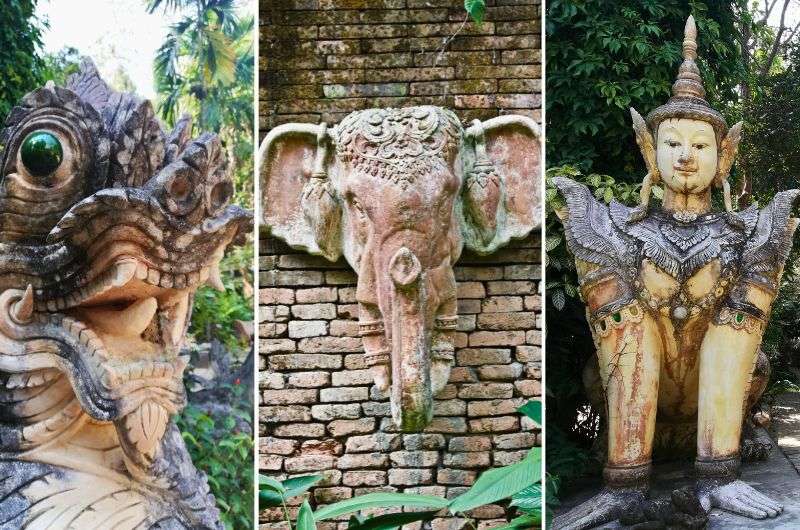
Wat Pha Lat temple is surrounded by statues like these!
I’m starting to sense a pattern on this list: hidden and not show-offy = Petra likes! But there are exceptions. Heck, there’s a temple made purely out of silver coming up soon!
Extras:
It’s in the middle of the jungle! What more extras do you need? Maybe just a reminder: you can either drive straight there or take the Monk’s Trail hike.

There are a lot of details to find at Wat Pha Lat, you’ll want to have about an hour to explore it all
Wat Pha Lat history:
Wat Pha Lat, also known as "Monastery at the Sloping Rock," is steeped in history and legend. The temple originally served as a resting point for monks on their pilgrimage to Wat Phra That Doi Suthep at the top of the mountain. But they weren’t the only ones using it to rest... According to legend, in the 14th century, the ruler of the Lanna Kingdom had a white elephant carry a relic of the Buddha (a shoulder bone) up Doi Suthep. The elephant chose to rest at Wat Pha Lat before continuing its journey to the top, where it eventually trumpeted 3 times and died, marking the spot where Wat Phra That Doi Suthep was built. The spot where he rested is where they built Wat Pha Lat. No wonder it’s so peaceful there!
Spoiler: That bone actually broke into two pieces before they put it on the elephant. The other half is enshrined at Wat Suan Dok, another Chiang Mai temple that also deserves a spot on this list.
Over the centuries, Wat Pha Lat evolved from a simple rest stop into a tranquil meditation retreat. Once a road was built all the way up the mountain, the monks no longer needed to rest at Wat Pha Lat while hiking up and down, and instead settled there in the new living quarters.
Wat Pha Lat remained relatively unknown to tourists until recent years, when the Monk's Trail started gaining popularity. Can’t lie, the trail was way more of an adventure a few years ago, which is kinda sad. Despite its increased visibility, the temple has retained its peaceful ambiance and is still ok on the crowd level scale. Let’s hope it stays this way for as long as possible.
3. Wat Phan Tao: Chiang Mai’s wooden wonder (now with missing magic backyard)
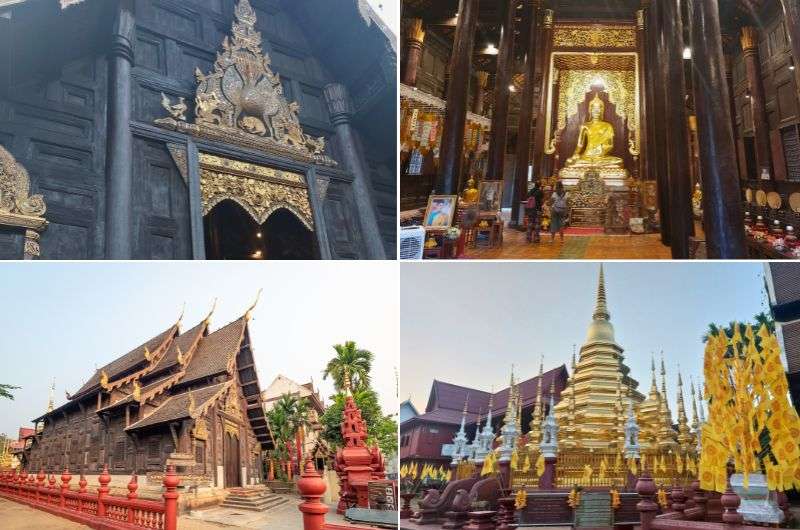
You can see the peacock symbol above the main entrance, the dark teak would, and the now-fancy chedi that is probably supposed to make up for the missing lake
- Price: free
- Location: In Old Town
Why it’s special:
This is my personal favorite temple in Chiang Mai, which, since I’ve seen LOTS of temples, has to count for at least something in this temple scoring system. It’s not because Wat Phan Tao is elaborate or massive or showoff-y in any way—on the contrary, it’s the lack of all those things that sets it apart. And it’s entirely made of teak. But there’s a big but that knocked it down to 3rd place…
Petra’s review:
Wat Chedi Luang’s neighbor, Wat Phan Tao, didn’t wow me with just its teak wood architecture and demure interior, it used to have a magical backyard. But on my last visit in 2024, that was completely gone. What’s utterly unfathomable to me was that they kept only the tree and parked their cars around it (wt*!). I just about shed a tear when I walked in! This place used to be so incredible, especially in the evenings with the lights in the tree—I never witnessed it with candles around the Buddha statue, but that would sure make anyone feel transported to a realm of enlightened tranquility or wherever good Buddhists go. Take a look at this:
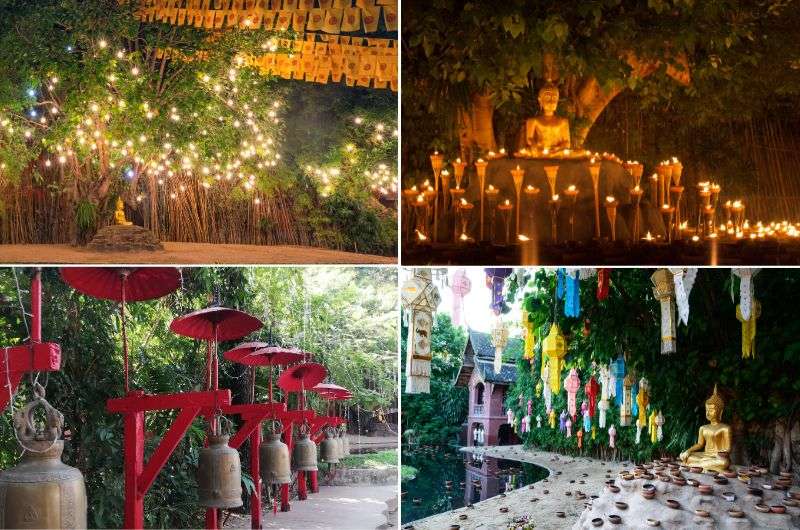
This is what Wat Phan Tao’s “backyard” used to look like…
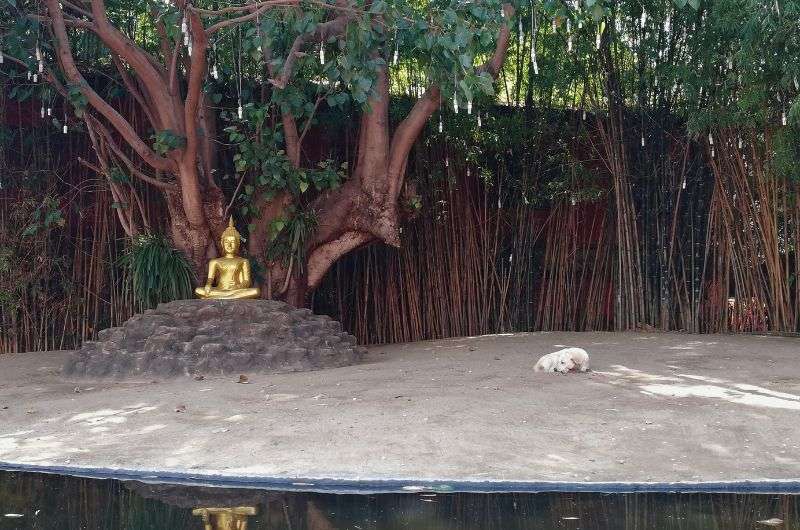
Look, even during the day with no lights, it was a peaceful for everyone! But now...
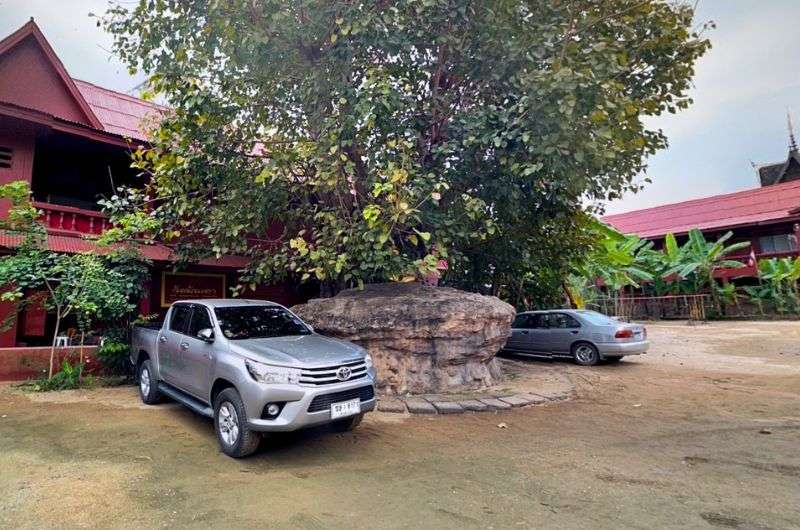
The mound is there, the tree is there, but instead of magic there’s a Hilux and a Sunny. I was so sad when I got there and the lake was no more! (photo taken off Google Maps because I was so shook I couldn’t even take a picture)
But unfortunately, the lake is no more, which, frankly, dims its sparkle a bit for me. Wat Phan Tao is still high on my list, but it might be in part because of the nostalgic memories I have of that little lake. Losing such a beautiful corner of spirituality feels like a profound violation of… of… heck, of the spiritual serenity temples are meant to provide! And of tourists wishing to come back and see the same thing they liked last time!!
Anyway, let’s talk about what you can see at Wat Phan Tao. There’s the main hall… and that’s about it. The chedi behind the hall is now completely golden, literally hurting my eyes in the strong sun. There are also monk’s living quarters and some sort of school there.
The main hall is cool, very cool. Teak, very teak. The intricate wood carvings that decorate the temple’s exterior tell tales of the Buddha’s life. The deep brown hue with golden accents is present throughout the exterior and interior, with the golden Buddha statue becoming the obvious focal point inside. If you manage to find a monk inside, his saffron robe will certainly shine brighter than in other more ornate brick and mortar temples in Chiang Mai.
I respectfully said hi to the main guy at the front (the statue) and proceeded to donate THB 20 for a bowl full of loose change, and throw one coin in each of the 108 bowls lining the left side of the temple. You know how I didn’t want to walk with the Buddhists at Wat Chedi Luang in fear of offending them with my non-Buddhist presence? Well, I had a similar thought at the bowls in Wat Phan Tao, but then I said to myself: what harm could a little good luck for me do? I can’t tell you though how stressed I got when I accidentally put 2 coins in one of the bowls! I almost panicked—should I take it back out? What if I take some else’s out instead?? Should I hope Buddha didn’t notice? Will I be a frog in my next reincarnation?!
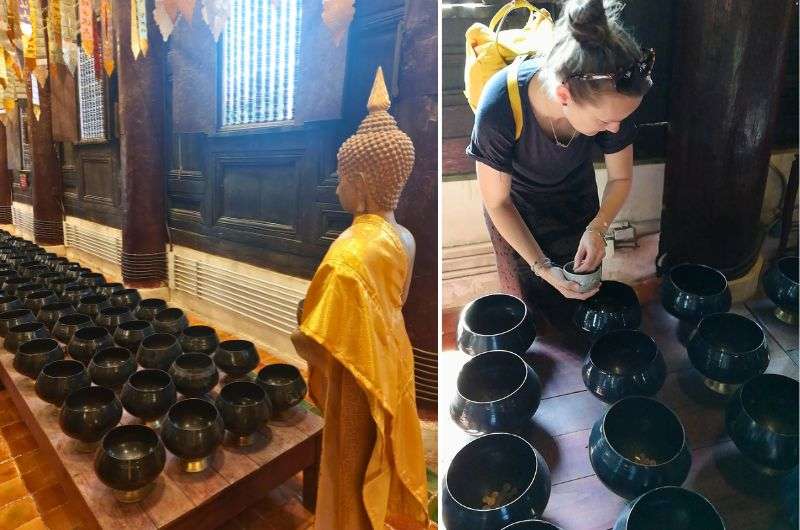
Well, wish me luck!
Why 108? According to Buddhism there 108 types of earthly desires and every Buddhist has to overcome these 108 temptations on their journey to nirvana. Putting a coin in each of the 108 bowls is said to bring good luck on the road there. I’m proud to say that I’m firmly on my way to “the place of perfect peace” because I did 108(ish) more bowls at the Reclining Buddha in Bangkok.
Extras:
No extras, but more like “un-extras” because of the missing Buddha island that I am sour about.
Wat Phan Tao history:
Wat Phan Tao might not be as famous as some of its neighbors, but it’s got its own unique allure. This temple dates back to the late 14th century, around the same era as Wat Chedi Luang. It’s like they were built to be historical besties! But Wat Phan Tao wasn’t originally a temple.
Back in the day, monks from neighboring Wat Chedi Luang lived there, and several rebuilds later, it was actually a royal palace for King Mahotra Prathet. You can still see the king’s symbol, a peacock, above the main doorway. The structure was later repurposed as a Buddhist temple, giving it a rich blend of royal and religious history. The current wooden structure is from the late 1800s, and panels from the royal palace were used for it. The teakwood viharn (assembly hall) that stands today is a prime example of traditional Lanna architecture.
4. Wat Suan Dok: Where the royal family rests… until the end of time
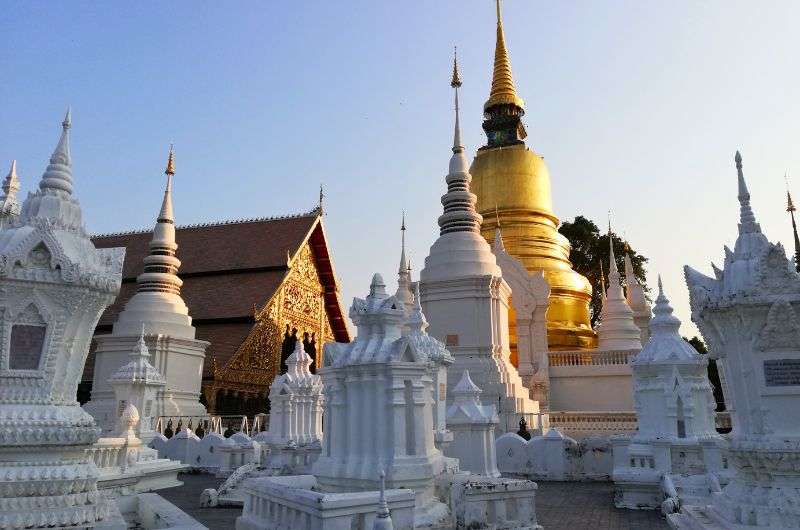
Wat Suan Dok at sunset
- Price: Free
- Location: outside of Old Town to the west
Why it’s special:
Wat Suan Dok is a photographer’s dream. The temple grounds are home to a stunning collection of whitewashed chedis that hold the ashes of Chiang Mai’s royal family. Plus, it’s much less crowded than some of the more famous temples in Chiang Mai’s Old Town, making it perfect for a quiet, reflective visit. Bonus points if you get there as the monks are chanting inside (me, I did that!).
Petra’s review:
I visited Wat Suan Dok after a day of temple hopping and indulging in some seriously delicious Thai street food, so I was a little tired, and a little hard to please, looking for something that’s not just another temple that looks like all the other temples. Basically, the bar was set high at this point, and I wasn’t going to be easily impressed.
No spoiler necessary since the temple is on this “best temples in Chiang Mai” list, so here’s the full rundown: The moment I walked onto the grounds, I was struck by the contrast between the bustling city outside and the tranquil beauty within the temple grounds. It felt like stepping into another world—a decidedly less touristy world. Temples on the other side of Chiang Mai’s moat have a whole other vibe, and I’m here for it.
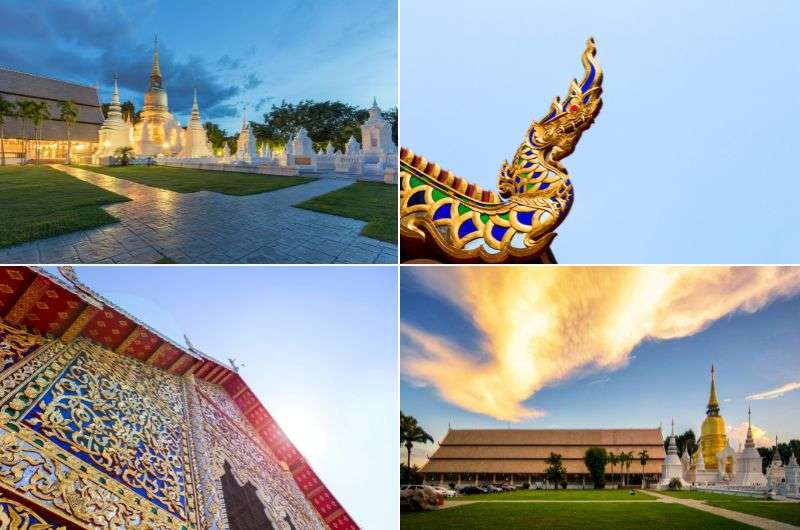
The stunning grounds of Wat Suan Dok
The first thing that caught my eye was the sea of white chedis. These striking structures are the resting places for the ashes of the old Lanna royal family. It’s like walking through a piece of living history and a cemetery all at once. Think "Downton Abbey" meets "Night of the Living Dead". Of course, I did this with my classic intrusive thoughts of “I feel like it’s inappropriate to be doing this”. But I did it anyway.
Then I followed entered the main viharn and was immediately drawn to the enormous Buddha statue inside, or actually several statues, all golden. And the very red and golden décor of the mostly wooden interior that’s basically open on the sides. Hello, nice breeze! The main Buddha statue, with its calm and serene expression, seemed to invite reflection and contemplation, so I accepted and sat down. It’s one of those places where you just want breathe and take it all in. Just make sure to sit with your feet NOT pointed at Buddha. He hates that. Actually, it’s disrespectful, but I’m trying to be funny here, ok.
One of the highlights of my visit, beside wondering around the chedis and being almost the only tourist there, was the presence of monks in the main hall. They were chanting, I was sitting behind them, trying to look as unoffensive as possible. It was great. But then it felt inappropriate to just get up and leave when they were still at it… Anyway, I managed to get back to my hotel eventually.
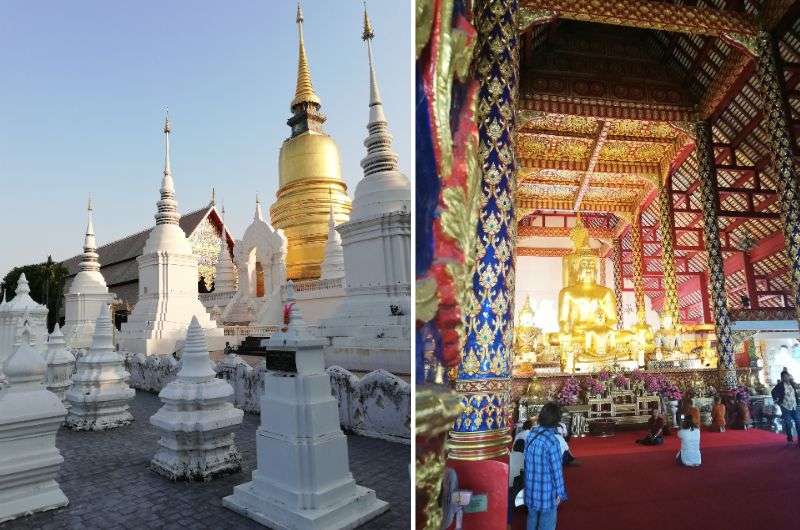
Wat Suan Dok is a vibe
Extras:
If you learn to pronounce the full name of the university that’s on the ground of Wat Suan Dok, you get a speed boost to nirvana. Try it: Mahachulalongkornrajavidyalaya University. It’s the oldest university in Thailand.
Wat Suan Dok history:
Wat Suan Dok, which translates to "Flower Garden Temple," was established in the 14th century. The temple was built on what was once a royal flower garden, hence the name.
According to legend, a monk named Sumana Thera brought a relic of the Buddha from Sukhothai, which miraculously split into two. Does this sound like the white elephant legend? Well, you’re not wrong: One part of the bone was enshrined in a chedi at Wat Suan Dok, while the other was placed on the back of a white elephant that wandered up Doi Suthep and eventually led to the founding of Wat Phra That Doi Suthep and Wat Phan Tao.
Wat Suan Dok is also home to the Buddhist University, where monks from all over Thailand come to study. This academic presence adds a vibrant and intellectual atmosphere to the temple, making it a hub of learning and spiritual growth. And history and cool stories.
5. Wat Phra That Doi Suthep: Mountain views, spiritual heights
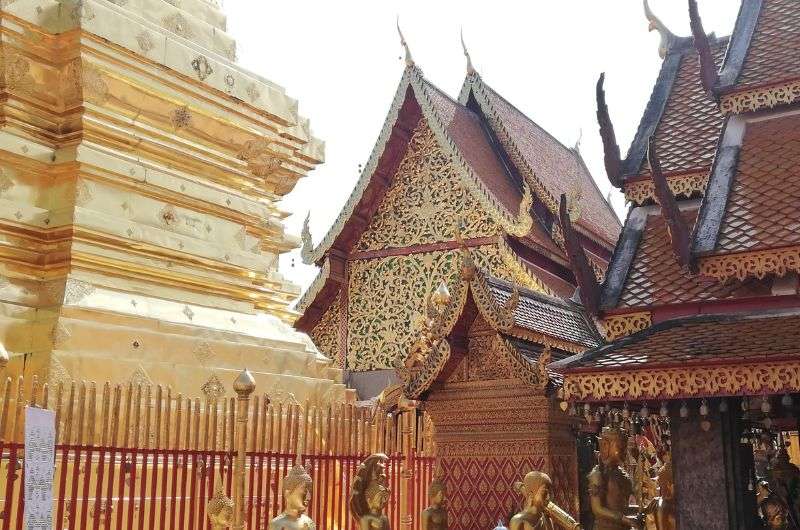
The limited color palette of Wat Phra That Doi Suthep
- Price: THB 30
- Location: on top of Doi Suthep
Why it’s special:
Wat Phra That Doi Suthep is like stepping into a treasure chest with gold practically everywhere you look. Perched on the top of Doi Suthep mountain, it offers views of Chiang Mai and the surrounding areas. Did I mention all the gold?
Petra’s review:
Visiting Wat Phra That Doi Suthep was an adventure in itself. You have the option to hike up the Monk’s Trail, but honestly, given the throngs of tourists shuttling up and down all day long, I decided to take the road like everyone else. Trust me, the steep hike isn’t necessary when you can just hop on a songthaew (red truck) and enjoy the ride. Or, if riding with a bunch of backpackers doesn’t sound enjoyable, take a Grab instead. It’ll only cost around THB 200 from the city center.
From central Chiang Mai, the drive (in a taxi) takes about 30 minutes. A red truck will take a little longer depending on how many times it will stop on the way. Usually though, it gets full right in/near Old Town and just heads up the mountain.
Once there, you’ll be dropped off in sort of a parking/drop-off area that is full of tourists and vendors. It is chaos unless you visit early in the morning (which, note to self, now sounds like a much better idea).
First, you need to make your way up the long dragon staircase—see, everyone gets their little hike on whether they like it or not! It’s about 300 stairs where you’re also dodging children dressed in traditional clothing asking for money. It’s a controversial thing that happens everywhere in southeast Asia, and the right thing to do is resist the urge to “help”.
Note: There is also a cable car that you can take instead of the dragon staircase, which I haven’t tried as I’m perfectly capable of walking up, but it could be useful for those with limited mobility though.
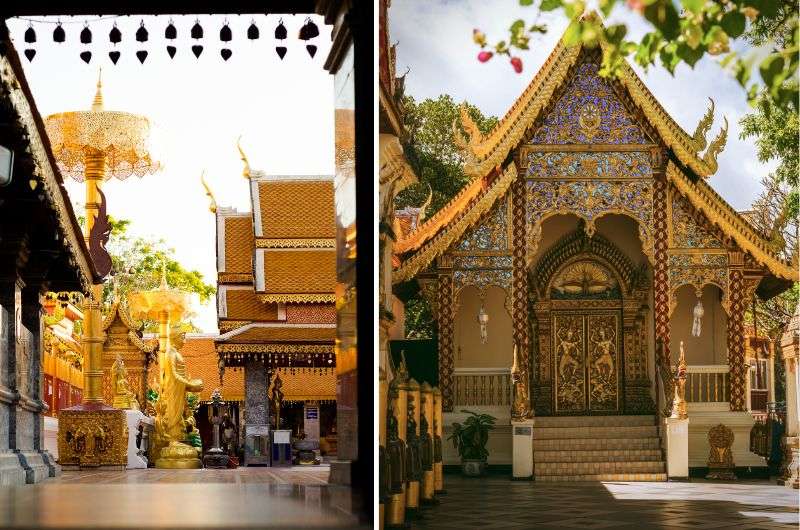
Wat Phra That Doi Suthep aka the place the White Elephant died when he carried Buddha’s bone up the mountain
Upon arrival, pay THB 30, take off your shoes (and hope you find them when you come back—not because they’d get stolen, but because there are so many shoes there). T e first thing that hit me was the sheer amount of gold. And people. But mostly the gold. The central chedi is a gleaming golden spire that catches the sunlight and hurts your eyes if you look at it from the wrong angle. As you walk around, you’ll notice that every corner seems to have a new golden statue, a shiny pagoda, or a beautifully adorned shrine.
And then there were the views. From the terrace, you get a panoramic view of Chiang Mai that’s absolutely stunning. It’s the perfect spot for a photo op, assuming you can find a moment when it’s not swarming with other tourists doing the same thing. I’ve only ever been there during the day, but apparently evenings are very nice too!
The temple grounds aren’t huge, but if you take your time to see everything, you could end up spending an hour there, especially if you venter to the cafe for a little refreshment.
I even signed my name on one of the golden cloths set out for tourists to write on, though I’m not entirely sure what these cloths will be wrapped around later, I like to think I added a special touch with my little contribution. And undoubtedly it will give me good karma, right? Along with all the coins I’ve put in bowls and at the various temples in Thailand, I at least deserve a happy coincidence every now and then, right?
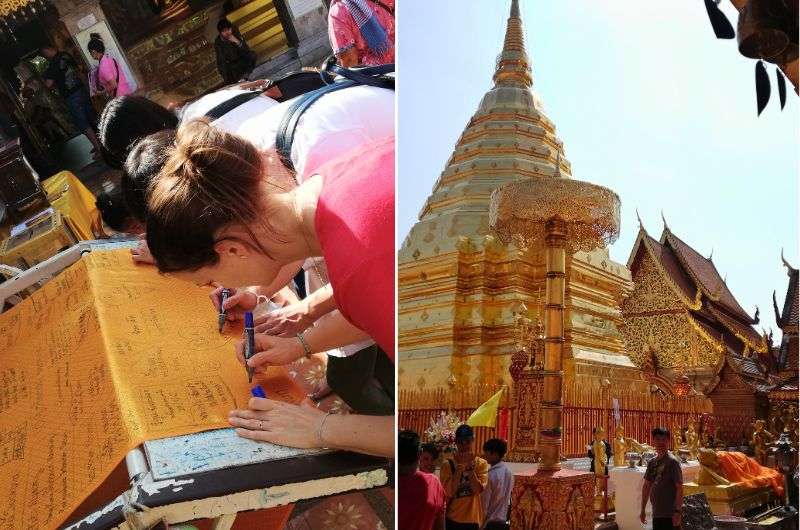
I left my mark at Wat Phra That
Extras:
Wat Phra That Doi Suthep is the most highly revered temple in Chiang Mai.
Wat Phra That history:
Wat Phra That Doi Suthep is one of northern Thailand’s most sacred temples. It was founded in 1383 when the first chedi was built. According to legend, a monk named Sumanathera had a dream that led him to discover a bone believed to be a relic of the Buddha (yes, this is the same story as from Wat Pha Lat and Wat Suan Dok). He brought it to the Lanna Kingdom, where the king decided to enshrine it.
To determine the exact location, the relic was placed on the back of a white elephant, which was then set free to roam. The elephant climbed Doi Suthep, trumpeted three times, and then laid down and died at the spot where the temple now stands. The king took this as a sign and ordered the construction of a temple to house the relic. The end.
Over the centuries, Wat Phra That Doi Suthep has been expanded and embellished, becoming the majestic site you see today.
6. Wat Phra Singh Woramahawihan: Lots of bling and real-looking wax monks
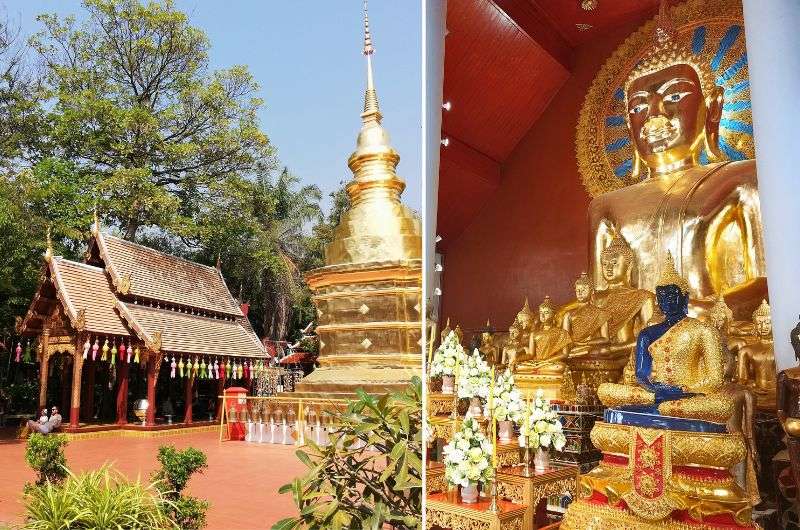
Wat Phra Singh’s bling
- Price: THB 20
- Location: Old Town
Why it’s special:
Wat Phra Singh is incredibly beautiful, elaborate, and downright royal! The interiors are a feast for the senses, showcasing intricate woodwork, stunning murals, and enough opulence to make you feel like you’ve stepped into a royal palace. Plus, there are some eerily lifelike wax monks that will make you do a double-take!
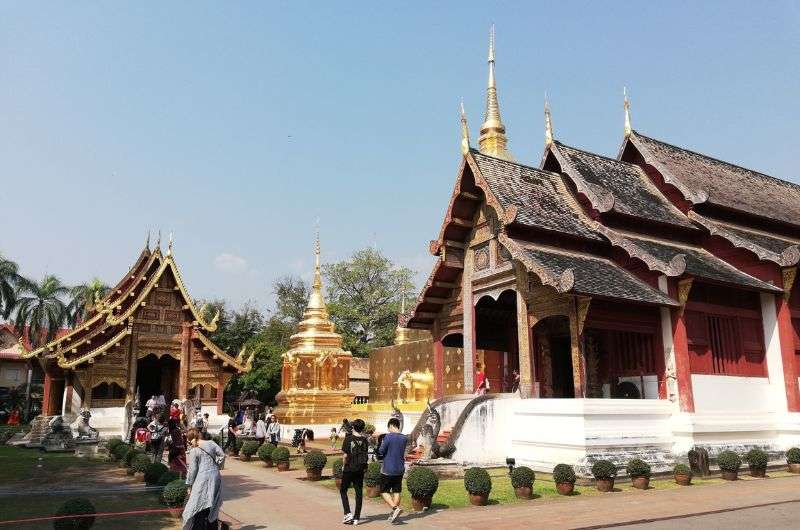
Wat Phra Singh
Petra’s review:
Wat Phra Singh is on everyone’s temple list and for good reason. The complex is sprawling (for a temple in Old Town), with several buildings and structures that each offer something unique. Like very realistic wax monks that freaked me out!
There are two viharns at Wat Phra Singh, with the smaller one housing the revered Phra Singh Buddha… or at least you can hope it’s him. There are two more Phra Singh Buddha’s in Thailand and all claim it’s the real one.
Both viharns are the epitome of elegance, with golden details that shimmer in the sunlight. The intricate wood carvings and murals on the wall had me snapping away, i.e. I kept wanting to take more detailed photos, the kind you never look at again because when you can’t see the big picture, they don’t really make sense.
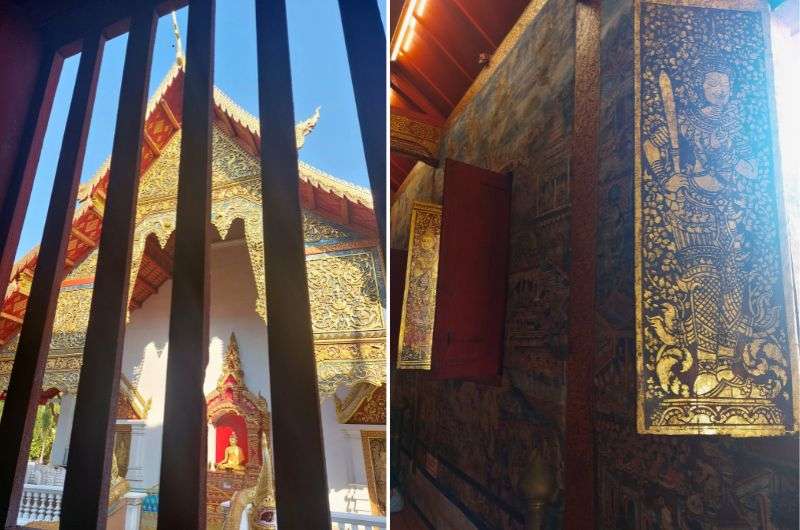
Details, details, details @ Wat Phra Singh
If you look closely, you can sort of follow along with the stories on the walls as they depict scenes from the Jataka tales, which talk about Buddha’s previous lives.
And then, I encountered the wax monks. Yes, you read that right—wax monks. Even if you’ve seen them before, they will still freak you out, because they are so lifelike that you’re never truly sure if they are real people or not… and there’s no respectable way to find out! They are located in one of the smaller buildings and are supposed to honor past monks that were, err, very good monks.
There’s also a lovely garden area where you can take a peaceful stroll, there’s quite a but more to see if you’re curious enough. You for sure won’t be able to not see the huge golden chedi (I realize I’m using the term “huge” lightly now that you have Wat Luang Chedi to compare it to).
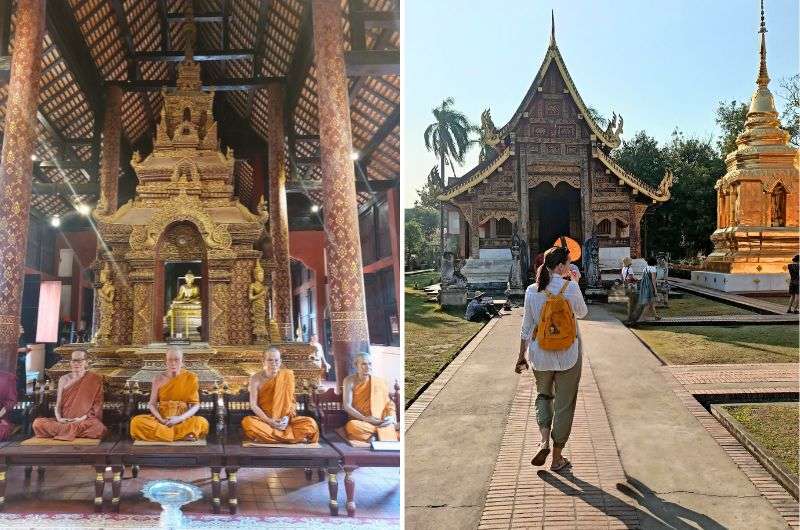
I know they aren’t real, but I don’t know, you know? And I can’t exactly poke them to make sure, so...
Extras:
I think the wax monks count as extra! Extra shocking!
Wat Phra Singh history:
Wat Phra Singh, officially Wat Phra Singh Woramahaviharn, was founded in the 14th century, so again, a very old temple, but very well preserved and in great shape. The temple was built to house the ashes of the king’s his father. In the 1920s, they did find, and then proceeded to lose, 3 urns in the chedi. Can you imagine? Rested in peace for centuries only to be taken out and lost, sheesh.
Over the centuries, Wat Phra Singh has been an important religious site and a center for the Lanna culture. The temple’s most revered image, the Phra Singh Buddha, is believed to have been brought to Chiang Mai from Sri Lanka. The exact origins of the statue are shrouded in legend, but it is highly venerated and a key pilgrimage site for Buddhists.
Wat Phra Singh has undergone several restorations, most notably in the 1920s under the patronage of King Rama VII, aka the guy that lost the urns. These restorations have helped preserve its historical and architectural integrity (except for the very important royal ashes), making sure that it remains a jewel of Chiang Mai’s cultural heritage.
7. Wat Buppharam: Good things can come in small packages!
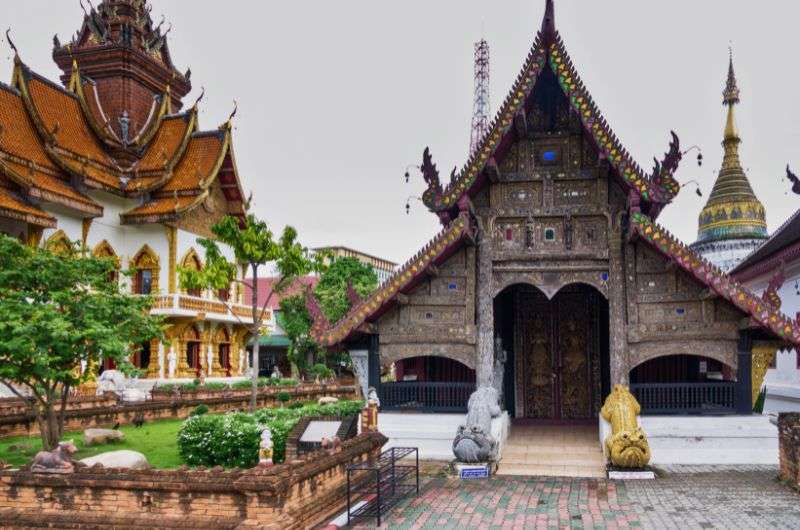
This is almost all there is on the Wat Buppharam temple grounds, but it sure packs a lot of detail in such a small space
- Price: THB 30
- Location: Outside of Old Town to the east
Why it’s special:
Wat Buppharam is not big—actually, it’s very small, or at least the main building of interest is—but it packs an astonishing amount of detail into its compact space. The carvings and paintings are eye-popping, with a variety of techniques and colors that leave you in awe!
Petra’s review:
My visit to Wat Buppharam was one of those lucky coincidences that turn an ordinary day (is there such thing in Chaing Mai though?!) into an extraordinary one. I was randomly wandering near Warorot Market, soaking in the atmosphere, when I stumbled upon this gem of a temple. I was blissfully alone, a sentiment I’m sure others who travel with kids (or husbands having their time of month, lol) can appreciate, so I thought “why not add a few minutes to my alone time?”.
From the moment I stepped onto the temple grounds, I was struck by its beauty. How come I didn’t come here on purpose?! I also immediately thought that the temple looks like a house I remember from an old folktale: Anybody here know Baba Yaga’s house? Here, I’ll help you:
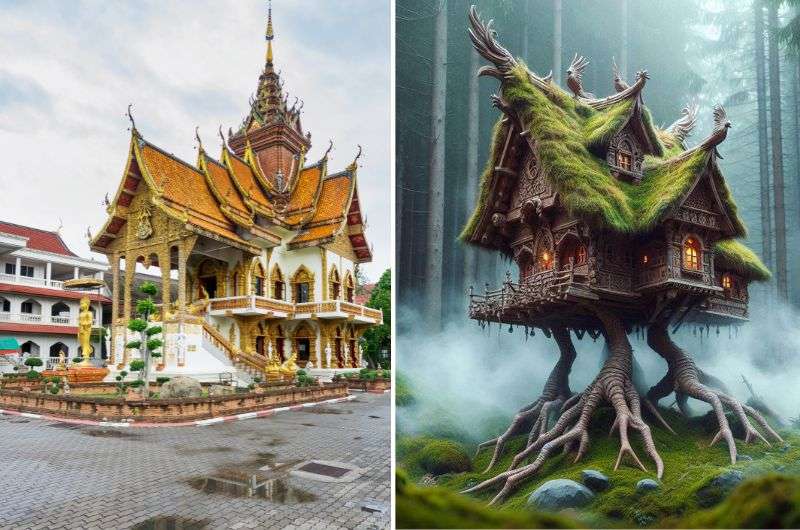
You see it too, right?? Now for the real question: What was first—Wat Buppharam or Baba Yaga’s house?
Despite its small size, this amazing building at Wat Buppharam is adorned with a staggering number of paintings and wall decorations of all sorts and techniques. It was mesmerizing. It’s like they crammed the decor of a cathedral into a space the size of a cottage. The level of detail is nothing short of eye-popping, with every inch covered in vivid colors and intricate designs.
The most ornate room is up a narrow flight of stairs, adding a bit of suspense to the visit—you have to line up to go up unless you’re lucky enough to be the only one there. It wasn’t crowded per se, but the layout and logistics of the up-one-way, down-the-other path slowed things down a bit. However, this just gave me more time to appreciate the craftsmanship and artistry of the temple.
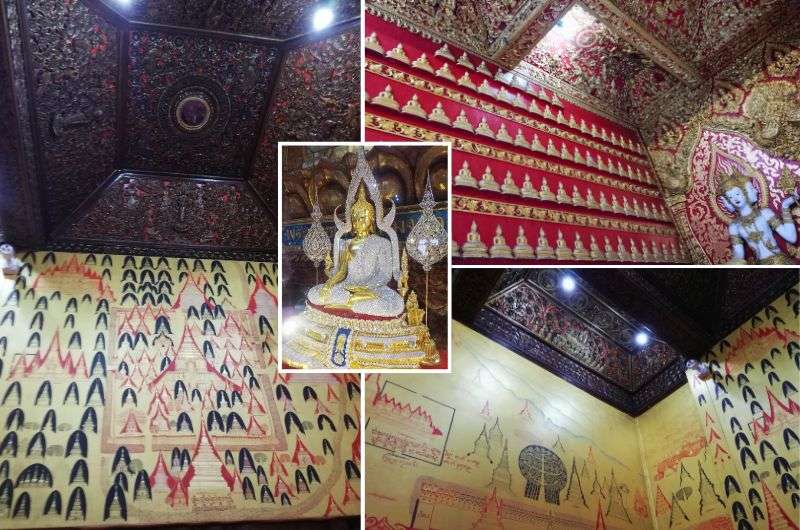
Inside Wat Buppharam
Inside, it’s a riot of colors and textures, with elaborate murals depicting various scenes from Buddhist mythology. The serene Buddha statues and the intricate altar pieces are breathtaking. Have I said breathtaking too many times yet?
You can enter several more buildings and find a lot of other interesting nooks and crannies, so go ahead and wander a bit. I honestly didn’t have much time to see everything in detail, and as far as my recollection goes, there’s nothing else on the grounds that trumps this temple building. The Burmese-style chedi is interesting too though, and I saw monks inside one of the halls.
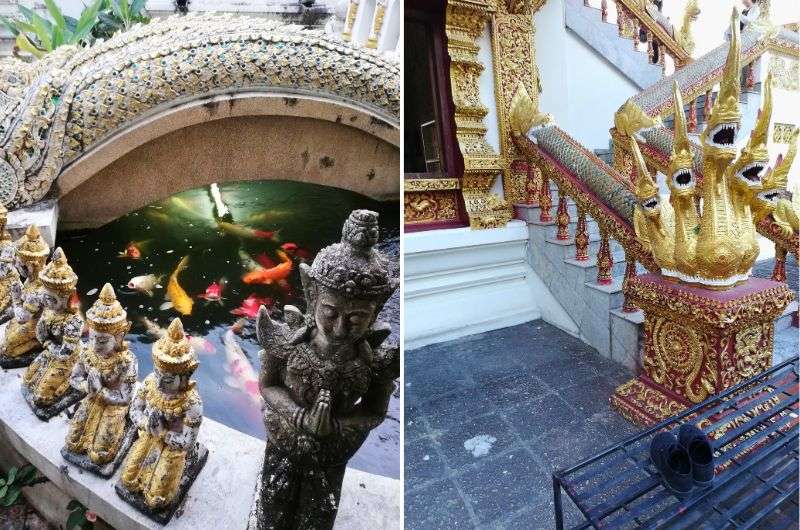
Details of the koi-filled fountain and of my shoes waiting patiently for me to come back
Extras:
Look for the fountain full of koi fish lined with Buddha statues. It’s cute.
Wat Buppharam history:
Wat Buppharam, also known as "The Temple of the Blossoming Lotus," was built in 1497. The temple has undergone several renovations over the centuries, each adding layers of artistic and cultural richness. It’s known for its beautiful Lanna-style architecture, characterized by its elaborate wood carvings and colorful murals. I’ve waxed lyrical about those enough I think.
Wat Buppharam has been a place of worship and meditation for centuries, attracting both locals and tourists with its serene atmosphere and artistic splendor.
8. Wat Umong The Suan Buddha Dhamma: The one with underground tunnels
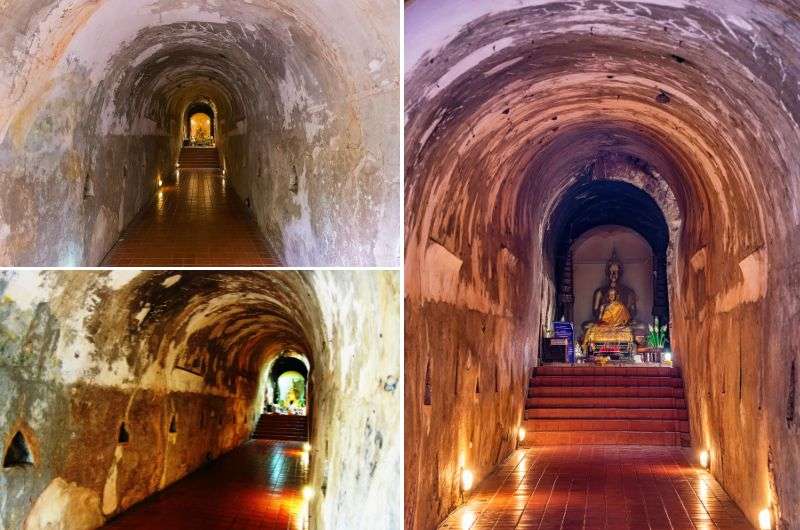
Unique atmosphere of Wat Umong The Suan Buddha Dhamma Tunnels
- Price: free
- Location: at the foot of Doi Suthep
Why it’s special:
Wat Umong The Suan Buddha Dhamma, commonly known as Wat Umong, is located in the forest and is unlike any other temple in Chiang Mai (or anywhere else, frankly), because tunnels! Underground ones, with Buddha statues hiding down there. There’s also a lake that may or may not cause you to have a heart attack like I almost did.
Petra’s review:
Just to cut to the chase, because I know you’re dying to find out what happened: A snake happened! I’m not Jan so that wasn’t something that sparked joy in me (here’s one of his articles where he talks all about his love for the serpents)\. Not that I hate them or anything, but this one was too big and too close for comfort. It was swimming in the lake and I had 2 choices—run or take a photo. So I ran. Sorry for no photographic evidence! Hey, I have a kid, I can’t afford to die!
Another thing that shook me at Wat Umong The Suan Buddha Dhamma is the quote “The lives of sentient beings are like clay pots, destined to break, sooner or later.” Doesn’t that just kick you in the soul? We’re mere pots! Sheesh, I didn't need to be reminded of my mortality quite so bluntly. What with the snake incident just a few minutes ago, you’d think they want to kill me.
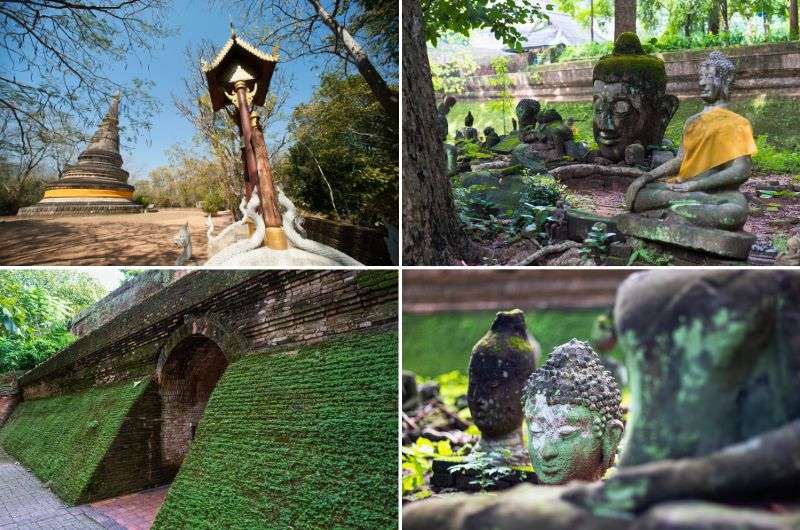
My visit to Wat Umong Suan Buddha Dhamma was a breath of fresh air, literally and figuratively (and not just because of the gulping of air I did when I saw that snake). Located outside the city center right near Doi Suthep (the mountain, not the temple), you feel like you are a world away from the urban hustle. Which, despite my love of Chiang Mai, is sometimes necessary, because the Old Town can be a lot. The forest setting is lush and quiet, making it the perfect spot for a little escape.
You'll see the pond shortly after you walk onto the temple grounds. I should mention it is nice and has koi fish in there that you can feed. But, um, I skipped that activity and fled for the tunnels instead.
The tunnels are what will etch Wat Umong The Suan Buddha Dhamma firmly into your memory—when's the last time you saw Buddha statues at the end of brick-walled underground tunnels?! For me, that would be never. It’s a maze of meditation cells down there, offering a cool, quiet space for contemplation (I couldn’t help but peek around every corner to check for snakes first though). The way they are lit adds to the unique atmosphere.
Of course, there’s the main hall and a chedi with some Buddha bits inside, but quite frankly, they were overshadowed by the, errr, other memories I made on this site. I mean the tunnels.
Above ground, the temple grounds are dotted with various statues and shrines, and it’s nice to just walk around and explore. There weren’t that many other tourists there when I went about mid-morning, so if you’re after peace and quiet, I’d say go as soon in the day as possible.
Wat Umong also has an open-air museum area with ancient relics and statues, adding an educational aspect to the visit. That’s where I saw the clay pot quote. You’ll also want to make a brief stop at the replica of an Ashok pillar. You can read a little about the establishment of buddhism in northern Thailand by King Mangrai on the plaque next to it.
Extras:
Wat Umong is home to "talking trees". Throughout the area, you’ll find trees with Buddhist proverbs and sayings attached to them. These wisdom-filled messages add an enlightening twist to your walk through the temple grounds, making it a reflective and inspiring experience (if you feel confident you aren’t kicking the bucket anytime soon).
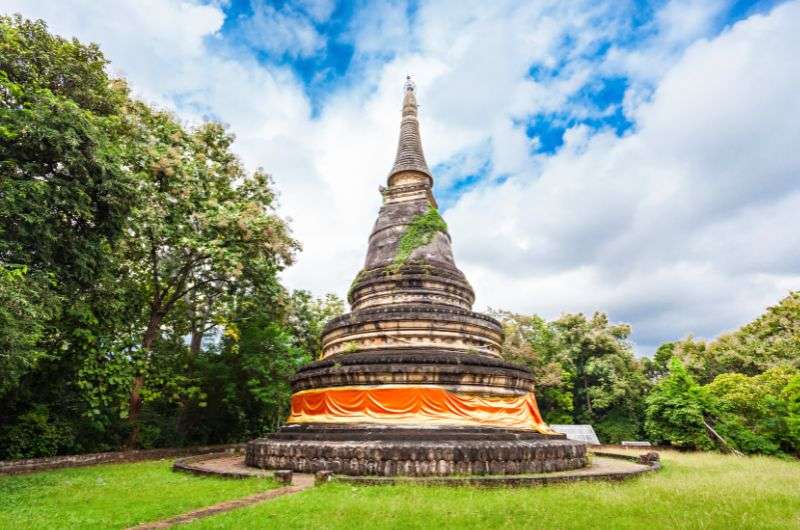
Wat Umong The Suan Buddha Dhamma is set in the forest, so it’s a treat walking around... but the real fun is underground!
Wat Phra That history:
Wat Umong Suan Buddha Dhamma, was established in the late 13th century by King Mangrai—this guy sure did a lot, didn’t he?! The temple was built as a meditation retreat for monks and was designed with a series of tunnels to provide secluded spaces for meditation.
The tunnels at Wat Umong were constructed to prevent distractions and help monks focus on their meditation practice. You can still see some very faded ancient murals in some parts of the walls.
During the 15th century, Wat Umong fell into oblivion and was abandoned for years. It wasn’t until the 1940s that the temple was restored and revived as a center for meditation and Buddhist studies. Today, Wat Umong is not only a historical site but also a functioning monastery and meditation center.
9. Wat Sri Suphan aka Silver Temple (not that I saw it or anything)
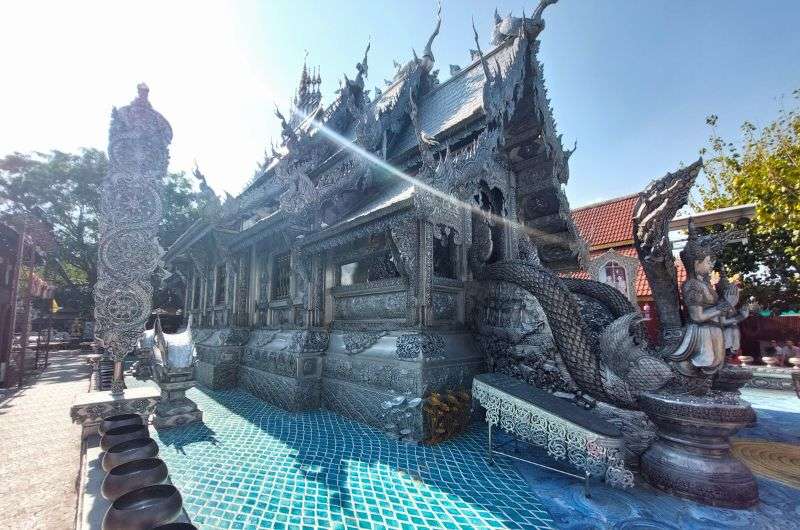
They’re not exaggerating when they call it the Silver Temple!
- Price: THB 50
- Location: Outside of Old Town to the south
Why it’s special:
Wat Sri Suphan, affectionately known as the Silver Temple, is a glistening marvel that is as dazzling as it is intriguing. Also, it has something to do with Marvel with a capital ‘M’—that’s right, you better pay attention to that intricate silverwork, because it’s a doozy! And not just because the Silver Temple gives off incredible amounts of light and heat and I felt like I was going to die of heat stroke while visiting. Seriously, this place is decked out in more silver than your grandma's best cutlery.
Petra’s review:
I visited Wat Sri Suphan after a somewhat underwhelming day checking out Mae Sa Waterfall and making elephant poop paper (don’t ask). Despite being exhausted and melting in 38-degree heat, I decided to swing by the temple in my shorts, not quite realizing I’m not wearing temple-appropriate attire. After a taxi drop-off (the Silver Temple is just to the south of Chiang Mai’s Old City), I found myself desperately trying to DIY something that would pass as respectable knee coverings from the random items I had in my backpack that day. Luckily, the ticket window had wraps to borrow—crisis averted!
The ticket lady started apologizing, and I initially thought it was about my attire. Instead, she explained that women aren’t allowed inside the Silver Temple. As an apology, or at least that what she made it out to sound like, she offered me a keychain and a free water ticket for the cafe behind me. I would have preferred to see the temple, but in that heat, free cold water sounded almost as good.
Wrapped up and hydrated, I strolled to the gleaming Wat Sri Suphan. I’m kidding, I power-walked, hiding in any inch of shade I could find. Women are banned from entering. Why? I don't even know anymore. I read that a woman vandalized the place way back when and here we are now with a collective punishment for the rest of us until the end of time. Or is it because we menstruate, and the spirits are wusses that could be disrupted by our filthy, filthy blood? Who knows. But I get it, it’s tradition, and am not (too) mad about it.
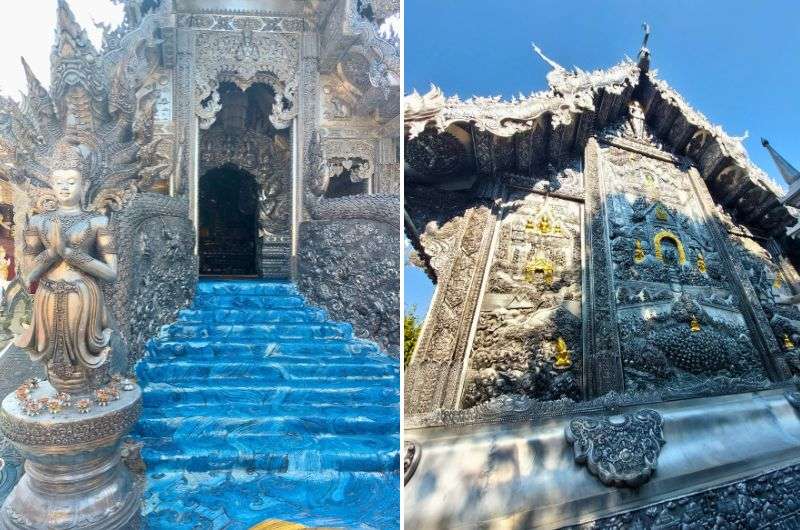
The front and back of the Silver Temple
The Silver Temple leaves us girls plenty to look at even from the outside. The carvings are wild if you look closer. If you're expecting something super traditional like the story of Buddha's life, you better brace yourself for the Marvel version—literally. Iron Man and Captain America make an appearance alongside Hello Kitty and some Disney characters! It's so unexpected and very entertaining trying to find yet another weird thing on the walls! Obviously, there's also a lot of Buddhas and monks on there, and the work that went into creating this masterpiece is unbelievable.
The interior, which I could only peek at and see diddlysquat, is just as wild. The floor is designed like a map of the Earth, connected by the zodiac, with aliens happily exploring our planet. The walls depict the Buddha’s life and other religious figures, so there’s still a lot that will fulfill your expectations.
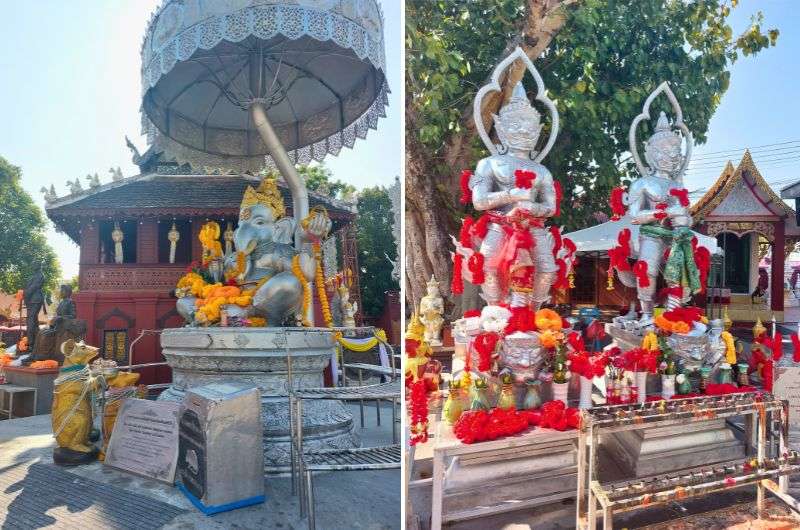
It’s not just the Silver Temple that’s silver! Everyone wants to participate!
Out front, there are cool statues and a few more places to explore. Women are allowed into the main hall, which is not silver at all, being fairly traditional in just about every aspect besides being festooned with colorful banners and baht bills during my visit. It was full of them!
There’s not a ton else to see at the temple, and I don’t think that was just be the heat talking. I vaguely remember some other buildings that left no lasting impression on me. But I swear that whenever I look at that silver bookmark now, I can still feel the heat I felt at Wat Sri Suphan.
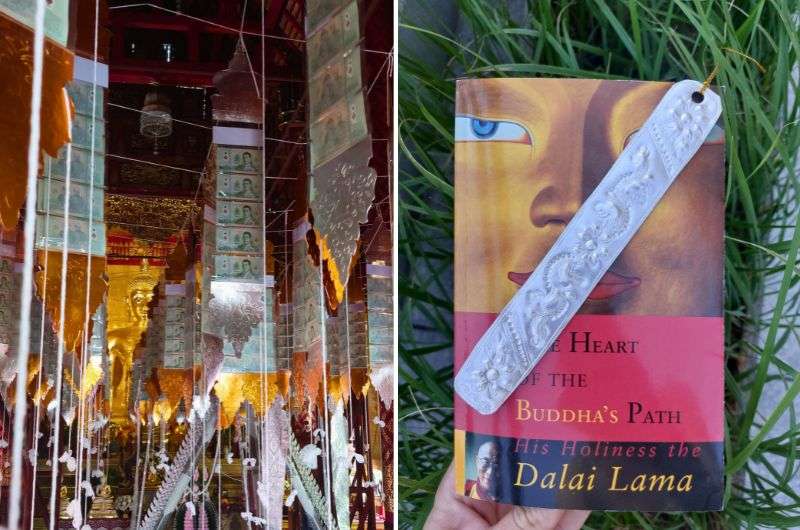
The interior of the main hall at Wat Sri Suphan was decked out with banners and money! And my new silver bookmark and reading material
Extras:
Make sure to check out the silver souvenir stalls. I mean the stalls aren’t silver, but they sell silver… you get what I mean. I bought a bookmark for my book on the Dalai Lama’s teachings—when in Rome!
Wat Sri Suphan history:
Wat Sri Suphan, built in the 16th century, was originally just another temple in Chiang Mai until it underwent a sparkling transformation. The temple’s silver makeover began in the early 2000s, thanks to the efforts of local silversmiths who wanted to showcase their craft. The result? A stunning blend of traditional Lanna architecture with a modern, metallic twist. This was obvious though, right? They didn’t have Ironman back in the 1500s, come on!
The temple now serves not only as a temple, but also as a center for learning traditional Lanna arts. Can you guess the main one they teach there? Please tell me you can guess it… it’s silversmithing! If you didn’t guess it, well, I’d recommend not ever traveling on your own.
10. Wat Chiang Man: The OG of Chiang Mai’s temples
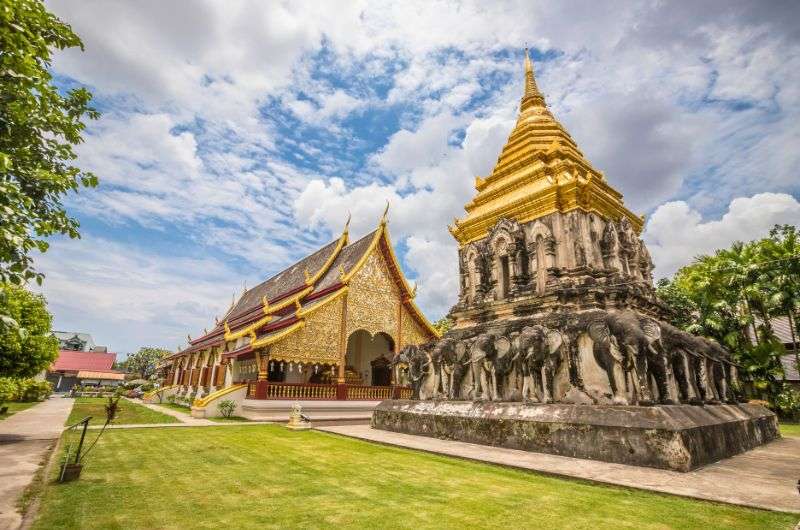
Wat Chiang Man is equisite!
- Price: free
- Location: in Old Town
Why it’s special:
Wat Chiang Man is the oldest temple in Chiang Mai, dating back to the 13th century. In a city with over 300 temples, it really feels like you’re taking a trip down memory lane at this place. And let’s not forget the charming elephant chedi that seems to have birthed the elephants now holding up chedis all over town!
Petra’s review:
Visiting Wat Chiang Man was like stepping back in time. Can you really say you’ve seen Chiang Mai’s temples if you haven’t gone to this one?? I don’t think so!
It’s close to Coucou Hotel where I stayed, making it a great place to go first thing in the morning... where my morning people at?! Aren’t mornings just better than everything else? Even better, you can go to Wat Chiang Man and then hop straight over to Blue Diamond The Breakfast Club for some of their famous pancakes. They also have fantastic tea and a garden where you can stay put while you’re waiting for your huge portion of food to digest.
Oops, I got a little sidetracked there... The first thing you’ll notice when entering Wat Chiang Man is the elephant chedi. The grandaddy of a chedi is supported by a circle of stone elephants that look like they were born there and then moved on to bigger and better things, like holding up the chedi at Wat Chedi Luang. The chedi holds some sort of relic that adds to the temple’s mystique. Do you also think that every chedi should have a little sign that tells us curious folks what it is that’s inside?! A QR code, maybe? No? Anyway, a quick google search told me that the chedi holds Buddha’s hair. Hopefully from his head.
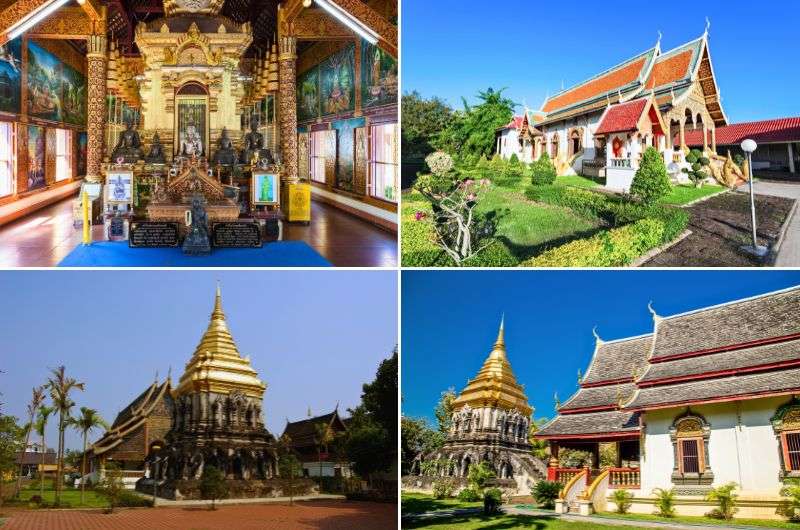
Wat Chiang Man
Next, I wandered over to the smaller viharn, which is a masterpiece in itself. The front golden carvings look like lace—wow! But even that doesn’t quite prepare you for what’s inside—if you read up and know what you’re looking at, that is. It’s not like your 600th Buddha statue is going to shock you in any way unless you’ve done a bit of homework. The main alter is a very busy place—the main Buddha image appears to be made of silver (but don’t quote me on that). Notice the little protective jail behind him: there’s a replica there of the Phra Kaew Khao Buddha, made of quartz crystal and dating back at least to the 15th century (though some, including the sign out front, claim it’s from the first century, which is hotly debated and very unlikely). This statue is believed to protect against disasters, having survived the pillaging of its original city. There’s also a similarly ancient and unfortunately also similarly small and hard to see standing Buddha carving made of stone, reputed to have rain-giving powers. He gets a lot of love right before the annual Songkran festival (the one where people throw water at each other).
In the larger viharn, you’ll find (among many, many others again at the main alter) the oldest Buddha statue in all of Thailand, with the year 1465 CE engraved on its base. He’s the one holding the alms bowl. They really should charge you to see these treasures!
There are a few more buildings on the Wat Chaing Man temple grounds, the most notable of which is a small building sitting in the middle of a little pond. The water protects the ancient scriptures written on palm leaves housed inside from bugs and, well, humans. Apparently, a bridge can be added when needed, but the less people are allowed in there the better. Humans are known to destroy things, after all. That means you can’t actually see the scriptures, but just knowing they are there made me really wish I could!
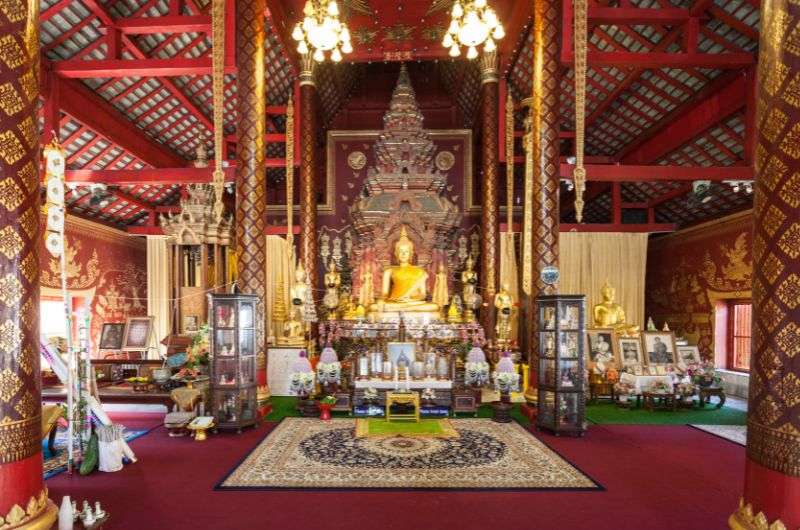
The oldest Buddha statue in Thailand lives in Wat Chiang Man
Extras:
The top part of the elephant chedi is in Burmese style, adorned with little bells that tinkle in the breeze. You can compare the style to the chedi at Wat Buppharam (no. 7 on this list) and Wat Lok Moli (up next), which are also Burmese in style.
Wat Chiang Man history:
Wat Chiang Man was founded in 1296 by King Mengrai, the founder of Chiang Mai, who used the site as his residence while overseeing the construction of the new city. This makes it the oldest temple in Chiang Mai, in case you weren’t paying attention in the previous section. The temple’s foundation marked the beginning of what would become the thriving capital of the Lanna Kingdom.
The architecture of Wat Chiang Man is a prime example of traditional Lanna style, though obviously over the centuries, the temple has seen numerous renovations and restorations. With each renovation the temple has picked up a little something new, a little something that looks different than it likely did in the original version.
One of the most notable historical aspects of Wat Chiang Man is its connection to the early rulers of the Lanna Kingdom. The temple served not only as a religious center but also as a political hub. King Mengrai himself hung out here!
Throughout its history, Wat Chiang Man has been a site of pilgrimage and worship, attracting devotees from all over the region. Its sacred relics and ancient statues have made it a focal point of religious activities and festivals in Chiang Mai.
The elephants at the base of the chedi symbolize strength and stability, which are core themes in Buddhist teachings. Those little bells on top? That’s a little slice of Burma for you.
11. Wat Lok Moli: The Mengrai dynasty’s favorite
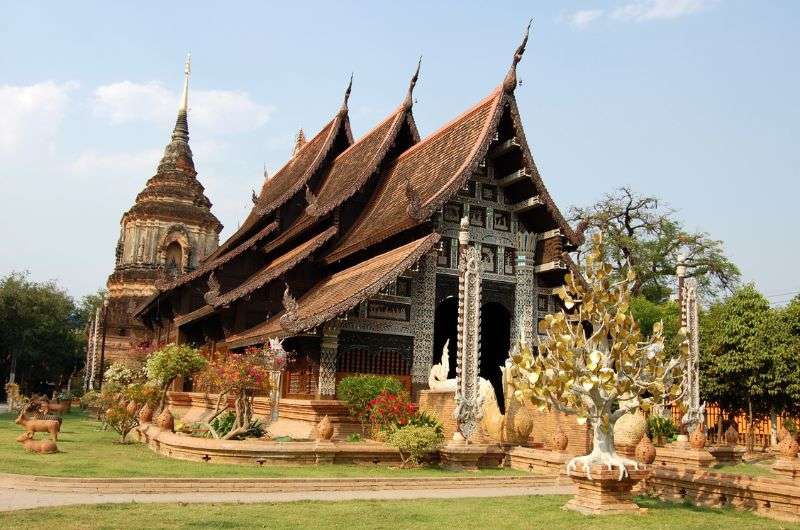
Wat Lok Moli temple is one of the oldest temples in Chiang Mai
- Price: free, with donations at the tunnel entrance
- Location: just to the north of Old Town
Why it’s special:
The unusually large grounds of one of the oldest temples in Chiang Mai, Wat Lok Moli, are perfect for spending a few extra moments of peace and quite before getting back to the busy Old Town. The chedi stands out with its bare brick structure and houses the ashes of several members of the royal family. Plus, the bright white color on the front of the temple was a refreshing change and really did it for me!
Petra’s review:
Wat Lok Moli was a delightful surprise during my exploration of Chiang Mai, one that I have my Grab scooter driver to thank for. So, thanks, man, I appreciate the tip! The temple is located just across the moat in the northern part of the Old City, and maybe because of this it could afford to keep a larger area for itself. The temple’s gardens are refreshingly spacious and beautifully maintained. If you’re looking for a place to decompress in, this could be your spot!
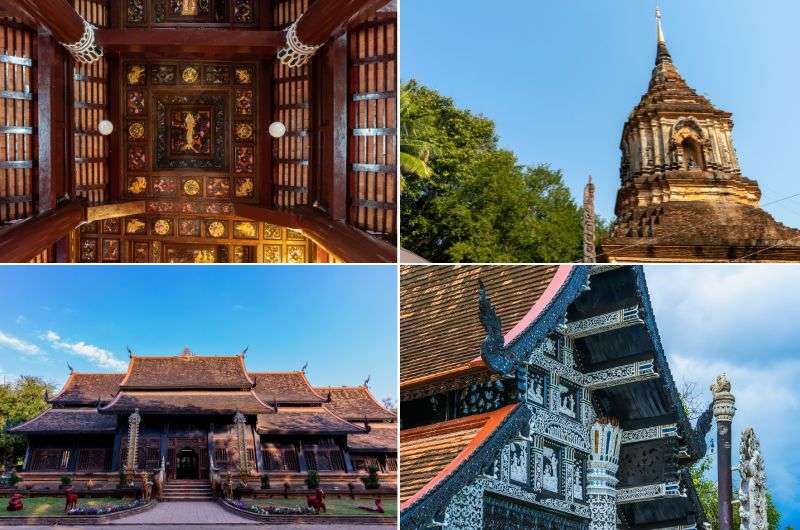
Wat Lok Moli details
Unlike many other chedis that are covered in gold or plaster, the one at Wat Lok Moli is bare brick, which gives it a raw, ancient feel. The only colors are the gold at the top and the colorful fabric wrapped around the bottom. It also includes Buddha statues in the niches that make it look like a tiny version of the chedi at Wat Chedi Luang. But wait, that’s not all! The chedi houses the ashes of several members of the Mengrai dynasty (you know, the ones that ruled the Lanna Kingdom in the very beginning).
Moving on to the main temple, I was captivated by the white wooden carvings on the front. The bright white color is unique and stands out against the more traditional temple designs in Chiang Mai. Striking! Or maybe it’s the contrast to the naked chedi, who knows. The interior of the temple isn’t anything that you haven’t seen before, it’s not especially ornate or anything, but hey, it’s a great place to hide from the sun!
Extras:
Interestingly, Wat Lok Moli is one of the few temples in Chiang Mai that faces north. Most Thai temples traditionally face east, aligning with Buddhist beliefs about the direction of enlightenment. However, Wat Lok Moli’s north-facing orientation is unique and has long puzzled historians. Some believe it might be due to the temple’s historical connection with Burmese monks, who might have influenced its unconventional layout. I can imagine the monks telling the king “it’s this way, sir!” without double-checking, only realizing after the fact they made a mistake but it was too late, and now the king’s favorite temple is all wrong because of it?
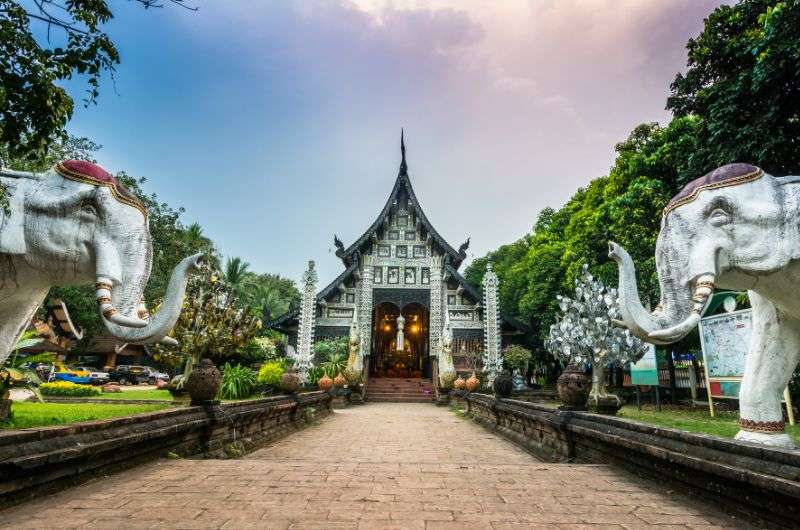
If you want to visit Wat Lok Moli, you’ll have to get past these two guys first!
Wat Lok Moli history:
Wat Lok Moli’s exact founding date is shrouded in mystery, but the earliest reference to the temple appears in a document from 1367. This historical record indicates that the temple served as accommodation for Burmese monks brought over to teach Buddhism in the region. This cross-cultural exchange played a significant role in the spread of Buddhist teachings in Chiang Mai.
In 1527, King Ket Keterecharaj of the Mengrai dynasty commissioned the construction of the chedi, built to house the ashes of the royal family. Seeing how well that went, he also oversaw the construction of the viharn in 1545.
Wat Lok Moli continued to be maintained by the Mengrai royal family until the end of their dynasty, reflecting their deep connection and commitment to this site, so when you visit, try to keep this little fact in mind. If it was good enough for them, it has to be good enough for you!
Thai temple vocabulary
Do you know the difference between a chedi and a stupa? I’ll take a wild guess and say you may need to brush up on some temple vocab. You’ll run into these words a lot when visiting temples in Chiang Mai, reading about their history, etc. Plus, why would anyone ever turn down the chance to educate themselves?
- Stupa – A bell-shaped mound containing Buddhist relics, usually the tallest and most prominent structure located on the principal axis leading from the main entrance as the focal point of a temple complex. Represents the enlightened mind of Buddha.
- Chedi – A chedi is basically a slightly more stylized version of a stupa and can also house relics/images. Chedis are frequently located within the central area of a Thai temple compound, facing the principal Buddha image in the main wihan hall. Each chedi level represents realms of existence. Shape symbolizes spiritual ascent to enlightenment.
Note: Chedi and stupa seem to be used pretty interchangeably, so don’t be too fussed about using the right word.
- Wihan - The main hall of the temple where all the really old Buddha statues hang out, haha. A wihan is the main viharn containing the principal Buddha image that gives each temple its spiritual identity. It’s also where monks and the community gather for religious ceremonies.
- Viharn - This is the general term for any monastery building or shrine room within a temple compound that houses a Buddha image for worship. So, a wihan is a specific type of prominent viharn.
- Ubosot - The ordination hall and most sacred area of the wat where monks are ordained before getting released into the wild temple grounds.
This post contains affiliate links. I earn a small commission if you make bookings through my links, at no additional cost to you. Thank you for your support!


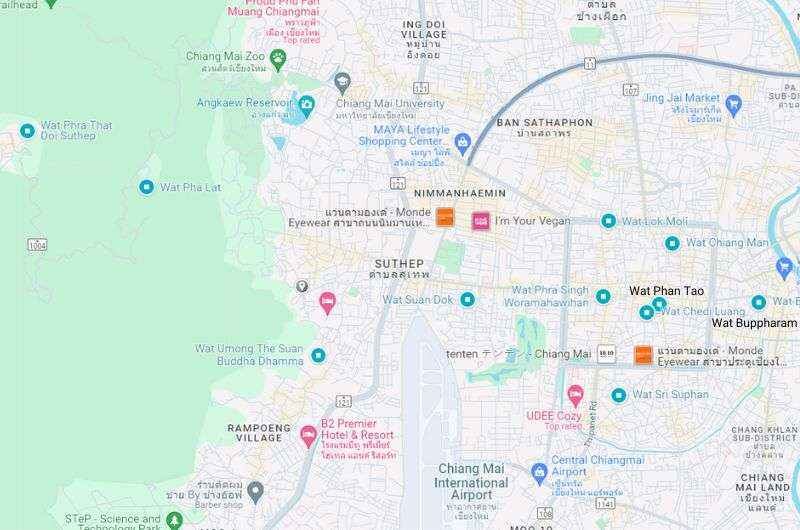
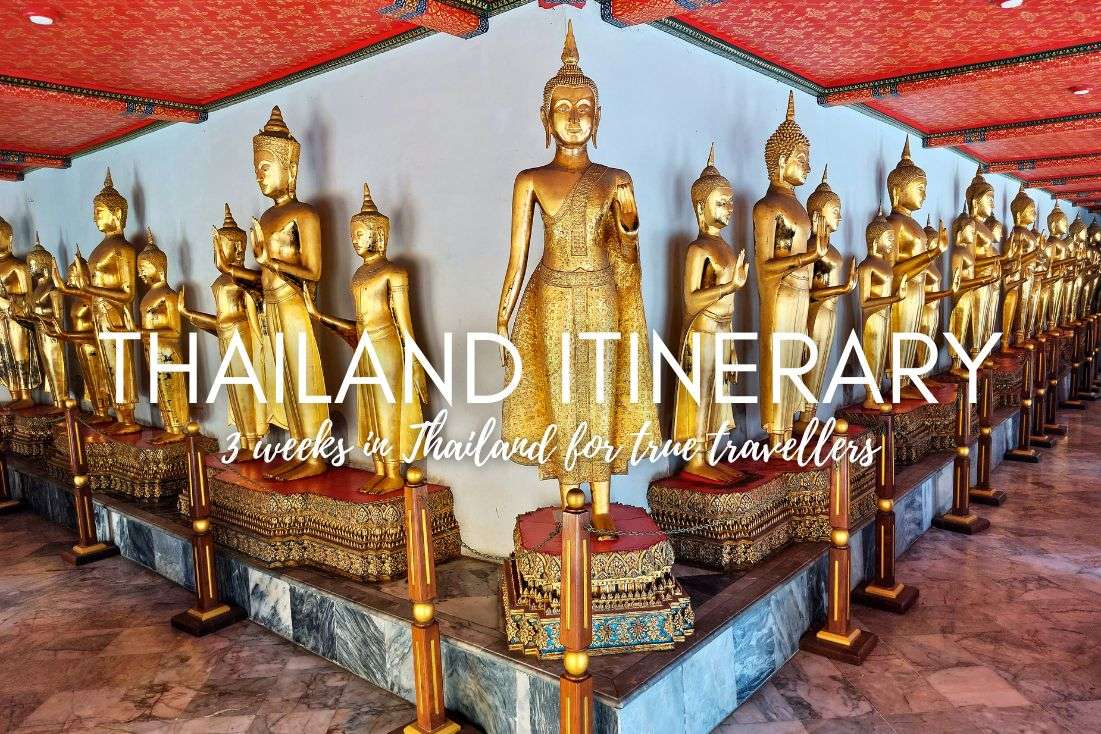
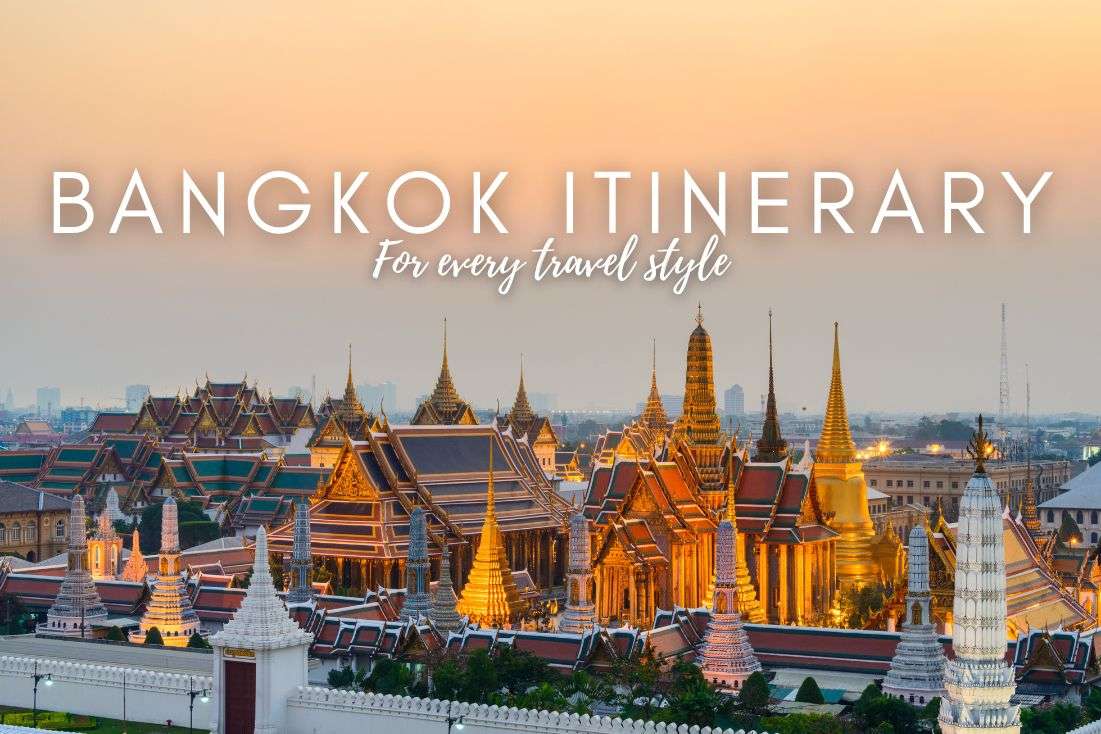






Comments | Thoughts? Give us a shout!